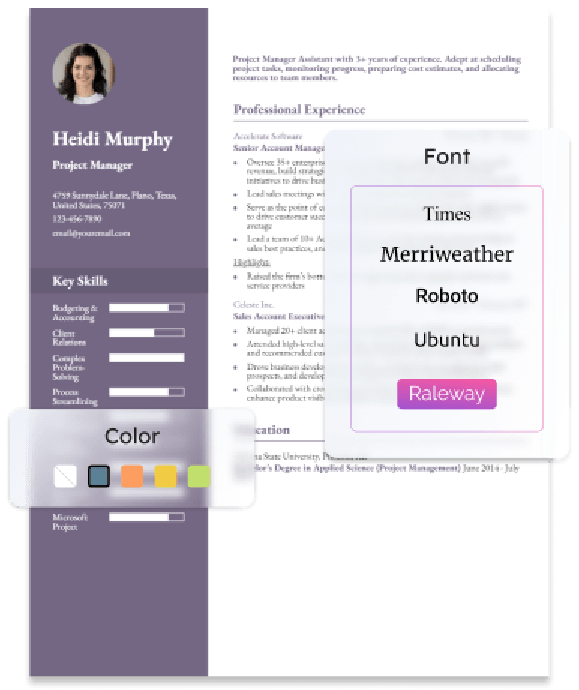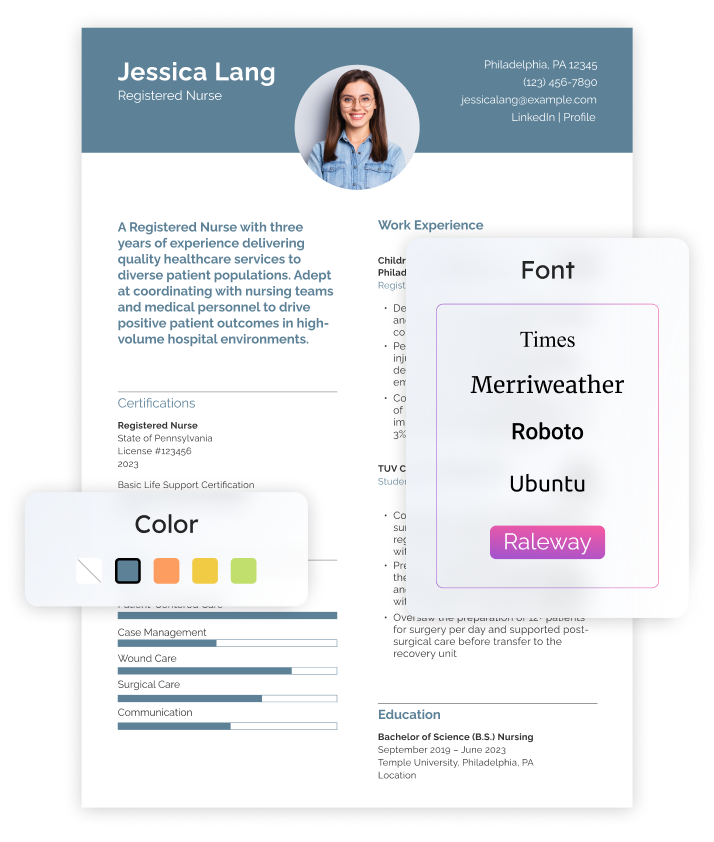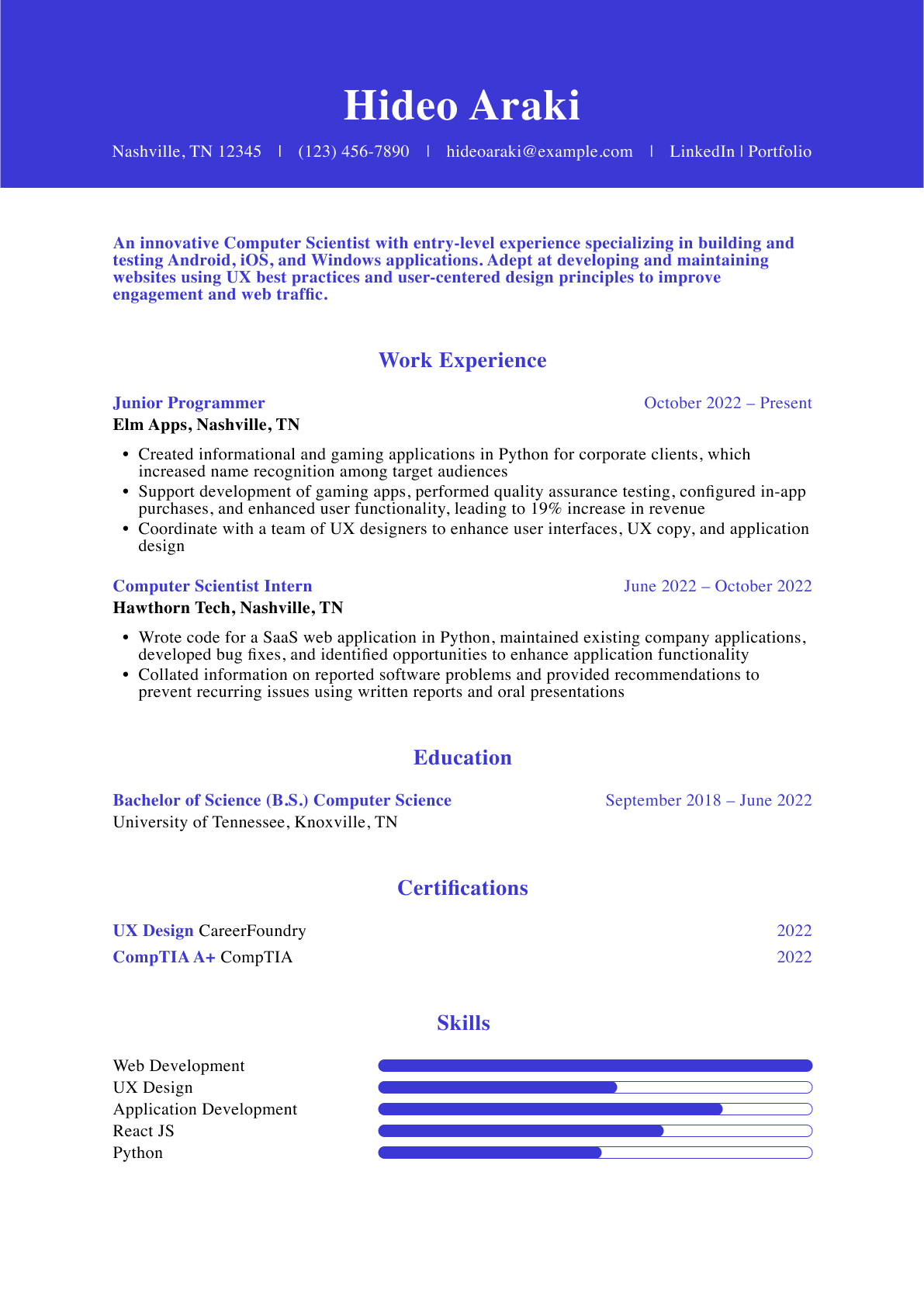To write a professional information technology (IT) resume, craft bullet points that draw attention to your strongest technical projects and achievements. As you detail your job responsibilities, emphasize the bottom-line value you generated for your company and team.
Hiring managers want a better understanding of your technical skills, but they’ll also look for examples of you having a positive impact on your previous organizations. Achieving this balance can be a challenging exercise, but it will also make for a much stronger resume. Throughout this guide, we’ll provide expert tips to aid you during the resume-building process.
“IT resumes need to strike a balance between technical depth and problem-solving results. Employers want to see not just what tools you use, but how you apply them to improve systems and user outcomes.”
— Carolyn Kleiman, Resume and Career Advisor
Most Popular Information Technology Resumes
Entry-level Information Technology Resume
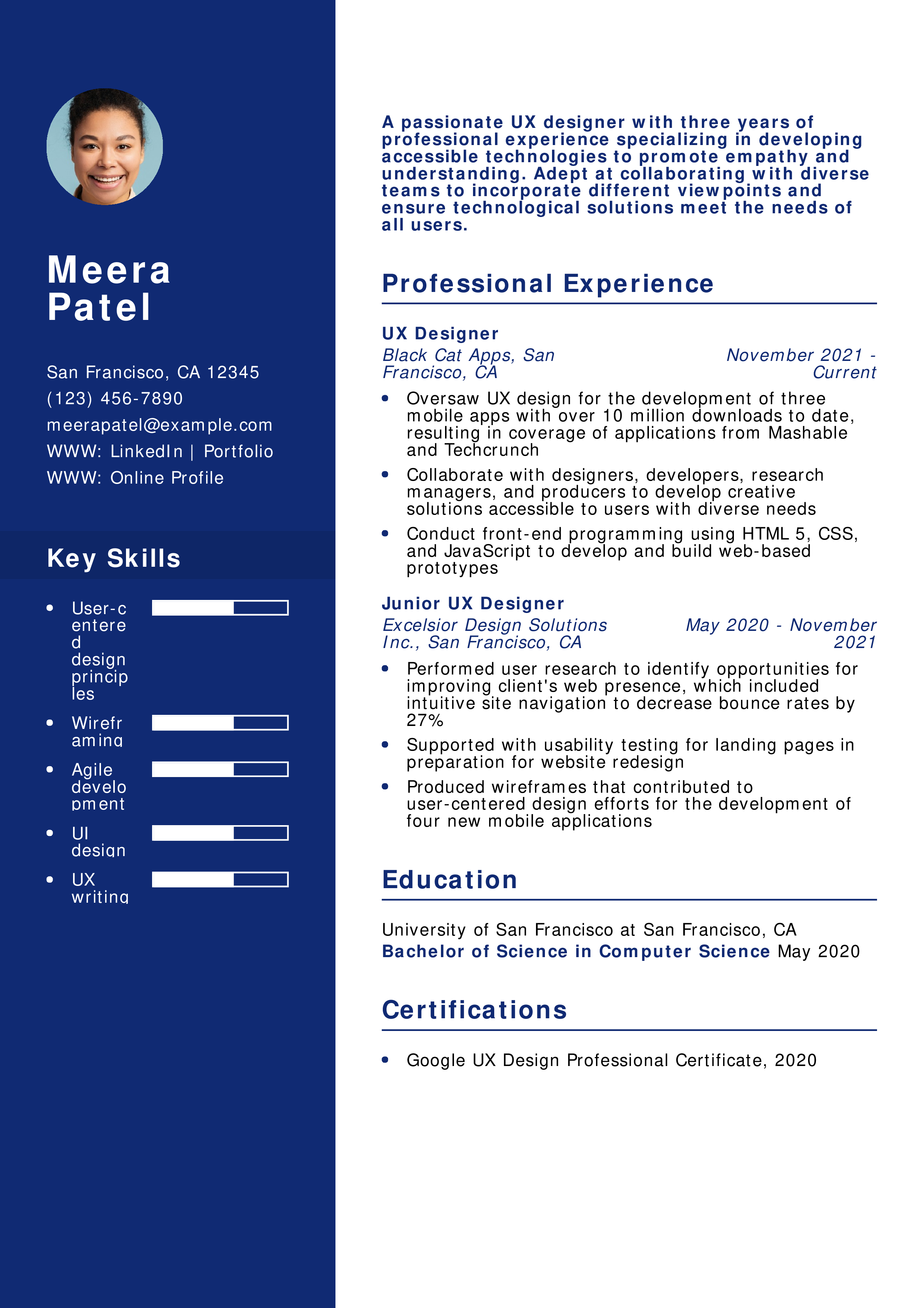
Why This Resume Is a Great Example
This IT resume example effectively captures the candidate’s comprehensive understanding of UX design principles. The content also tells a story, emphasizing a commitment to developing accessible technologies. These unique details can sometimes make all the difference in grabbing the hiring manager’s attention during the job search.
Mid-career Information Technology Resume
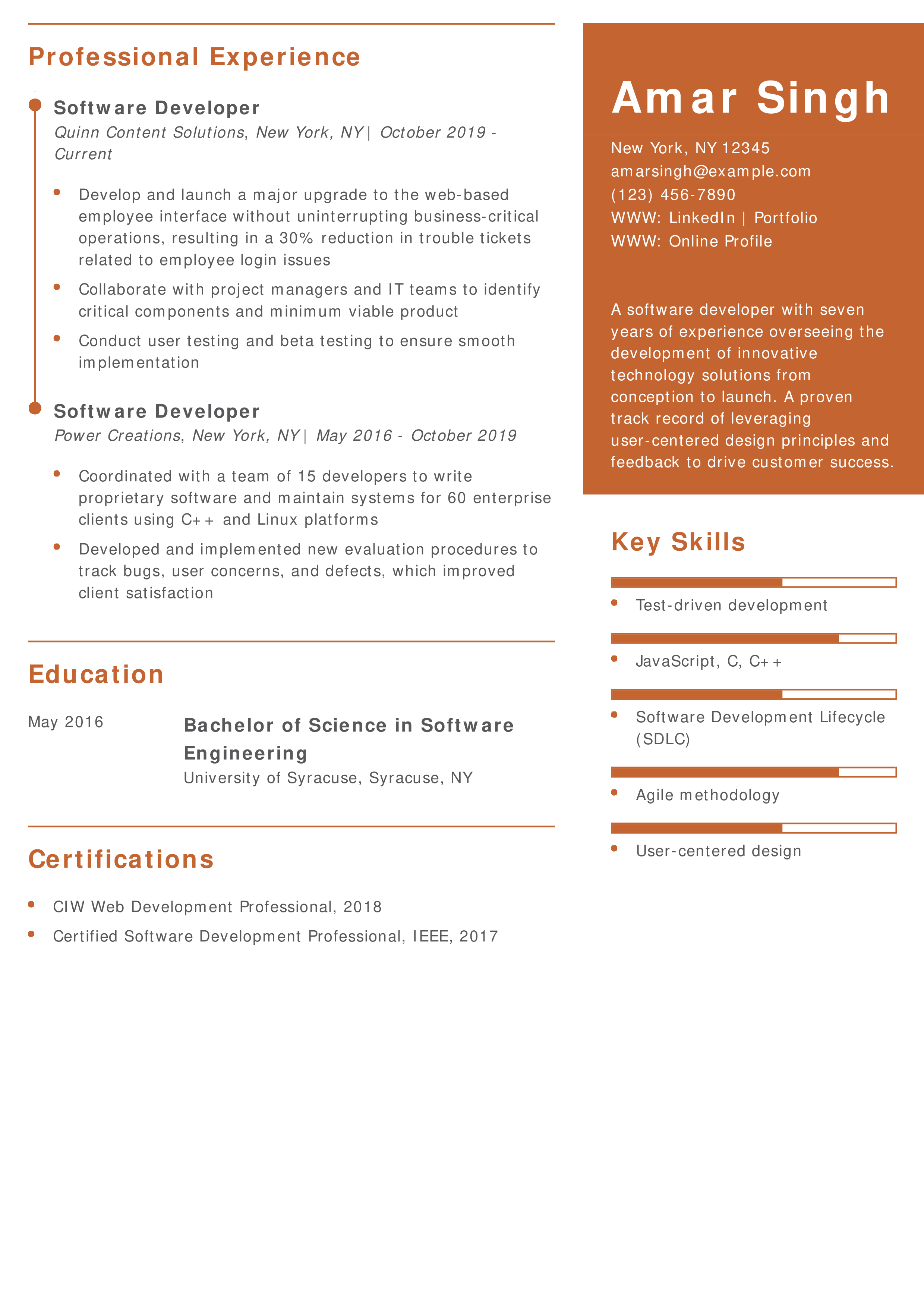
Why This Resume Is a Great Example
In this IT resume example, the candidate emphasizes their broad array of technical knowledge by illustrating key projects throughout their career. Rather than simply mentioning an increase in efficiency, the software developer provides a more tangible result for their web upgrade project. Painting a clearer picture of your background is much more effective than simply providing vague descriptions and buzzwords.
Senior-level Information Technology Resume
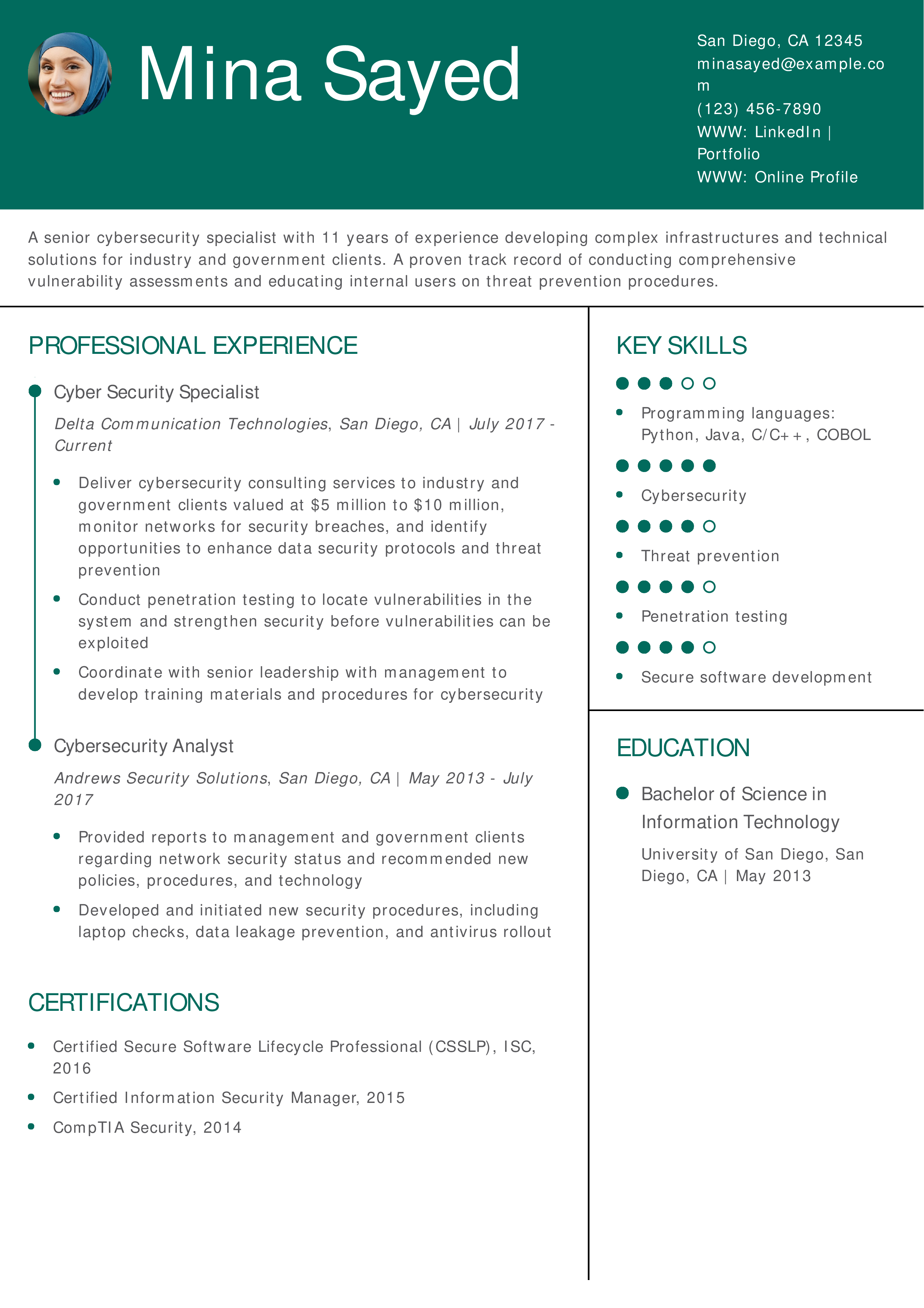
Why This Resume Is a Great Example
This IT resume example highlights the candidate’s comprehensive background in cybersecurity using strong metrics. Mentioning their experience working with government clients adds a new dimension to the story, as this establishes a sense of scope for the hiring manager.
IT Help Desk Resume
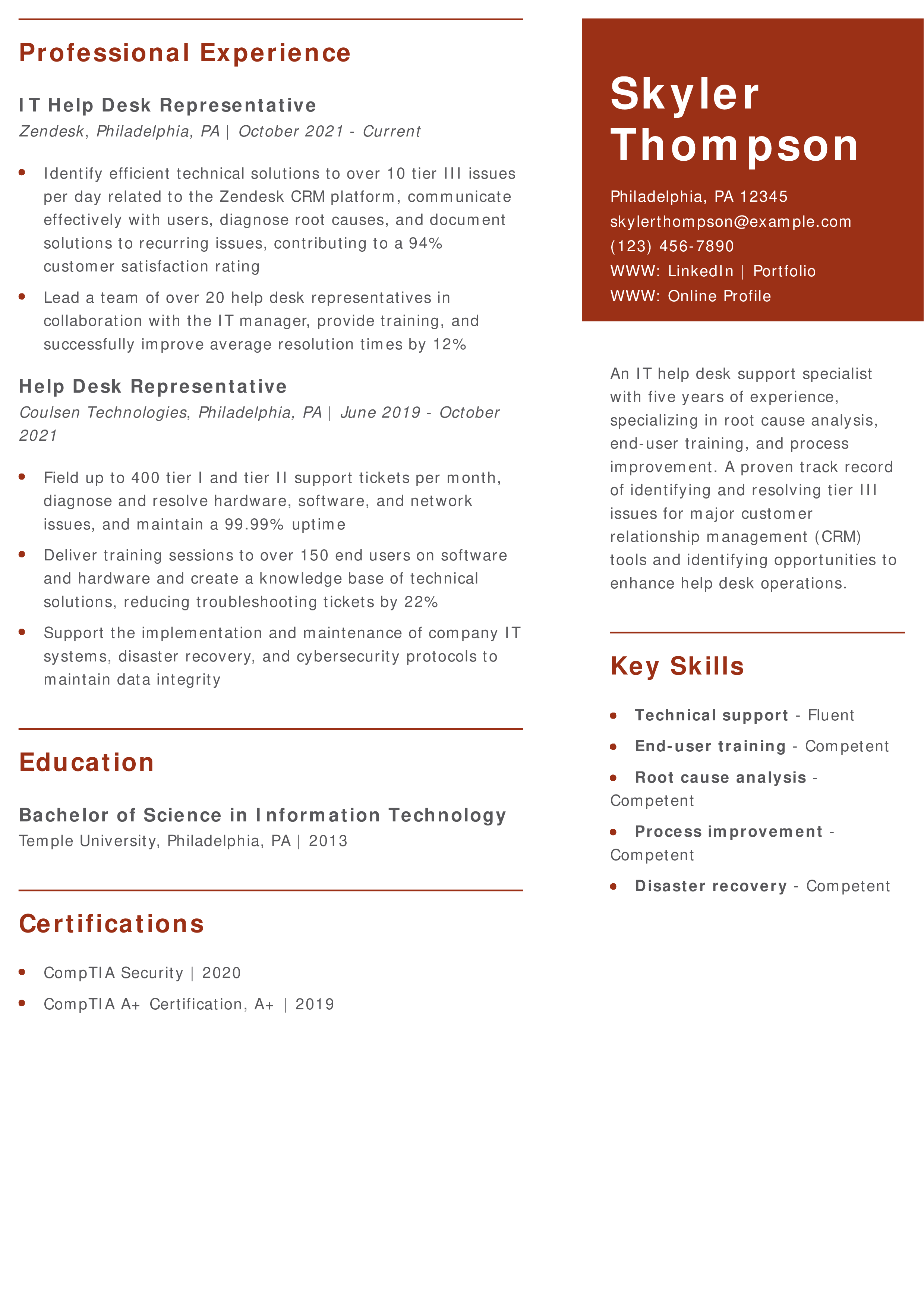
Why This Resume Is a Great Example
In this IT resume example, the applicant is targeting help desk representative roles. These positions tend to have very generic descriptions, so it’s important to be as specific as possible when describing daily responsibilities. The candidate leverages hard data to their advantage, painting a compelling picture of their achievements.
IT Director Resume
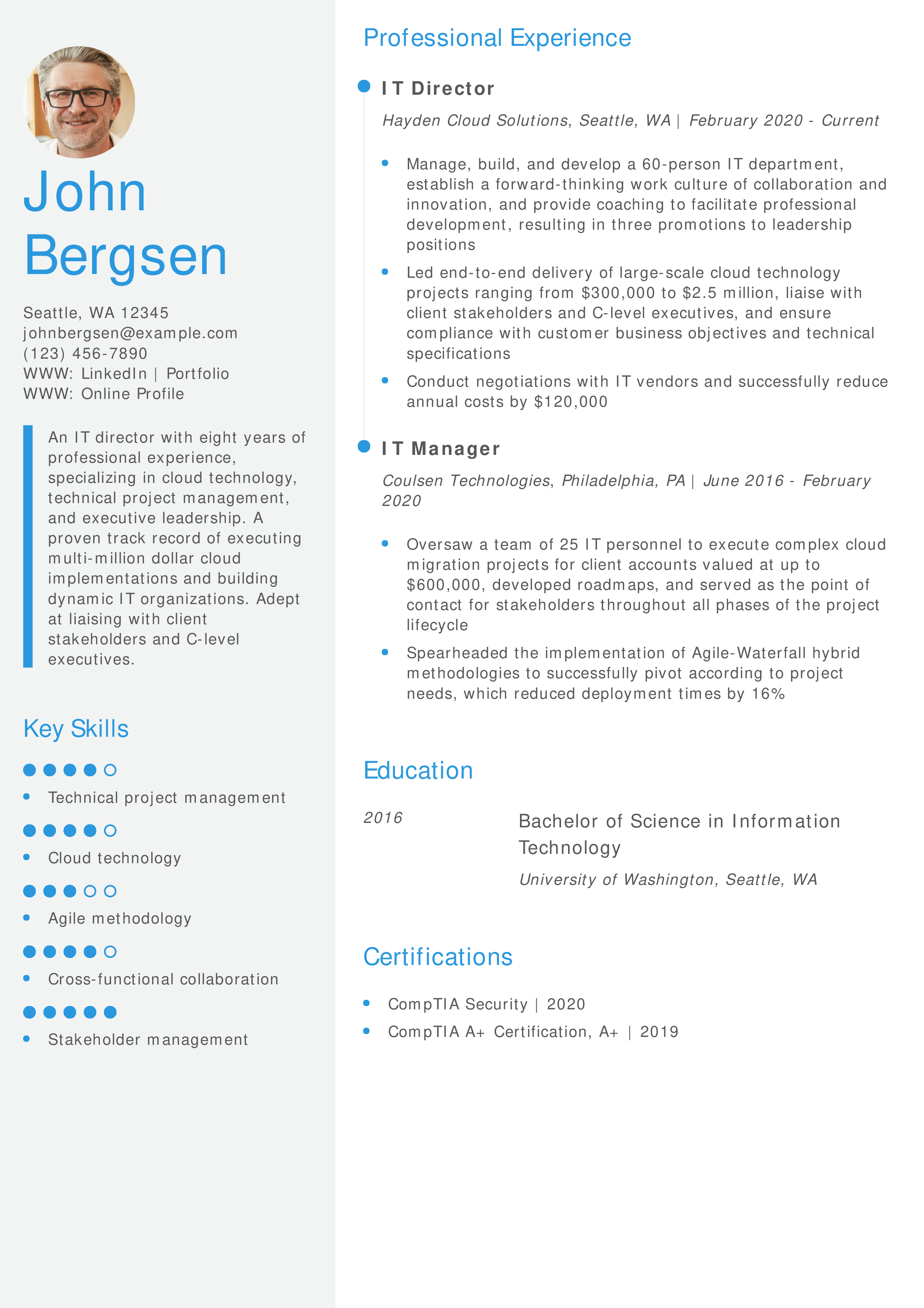
Why This Resume Is a Great Example
Illustrating technical knowledge and leadership capabilities is essential when pursuing higher-level positions within the technology field. In this IT resume example, the candidate demonstrates their ability to build high-performing organizations and execute multi-million dollar projects.
IT Support Resume
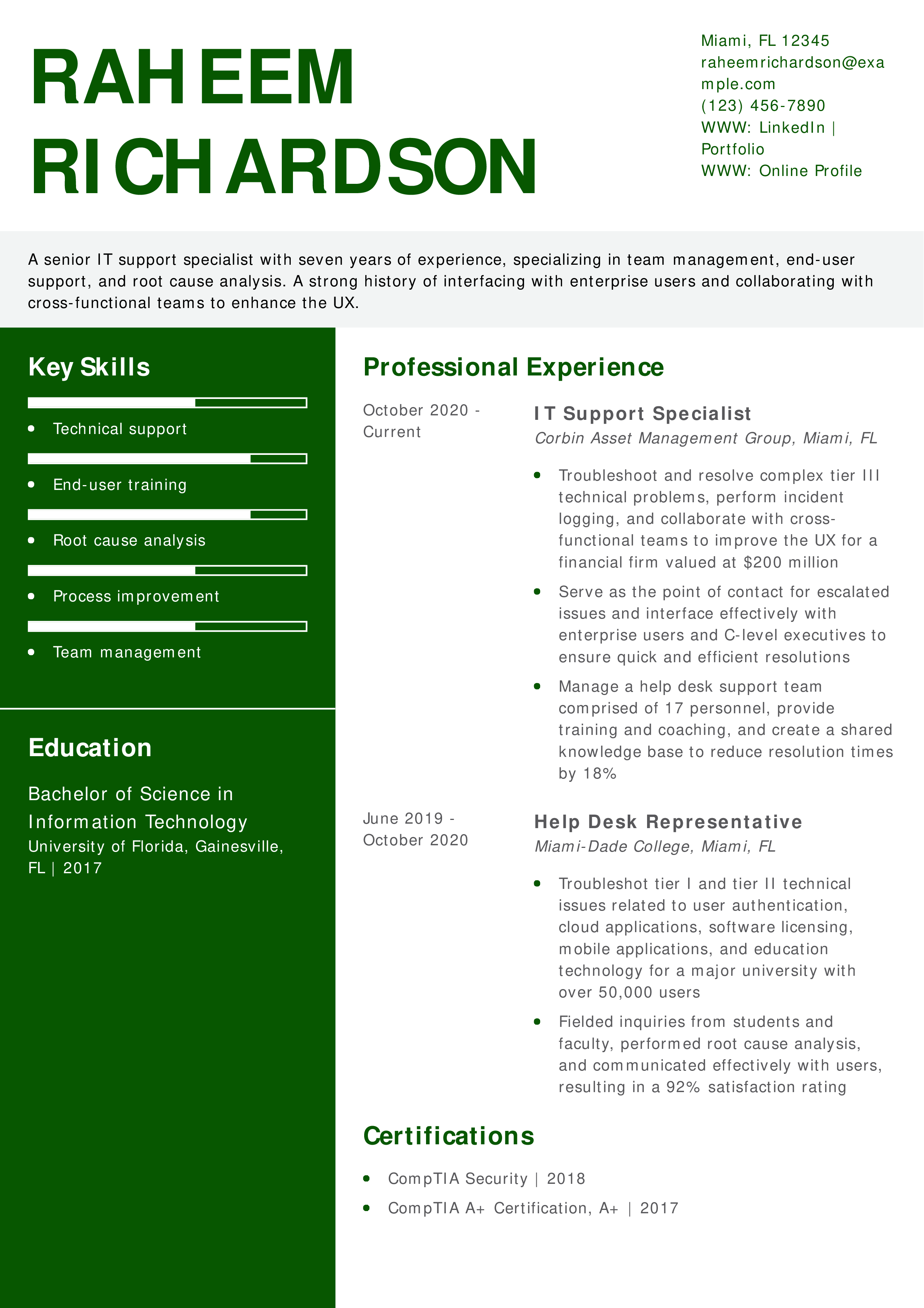
Why This Resume Is a Great Example
This IT resume example highlights the candidate’s ability to solve escalated technical issues, train support teams, and interface effectively with users. They also quantify their achievements using compelling metrics and data, which are sure to stand out to potential employers during the hiring process.
IT Analyst Resume
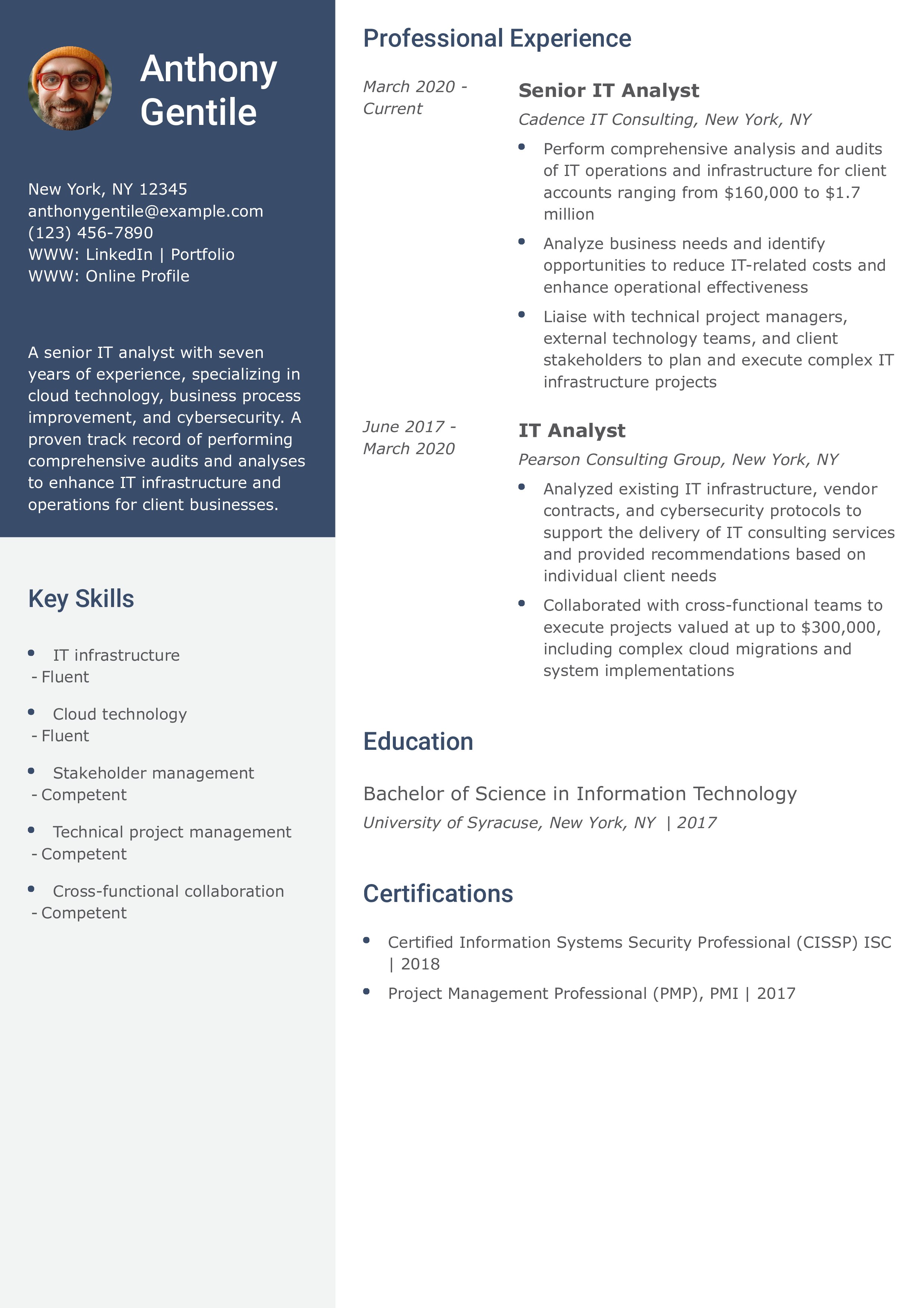
IT Systems Support Specialist Resume
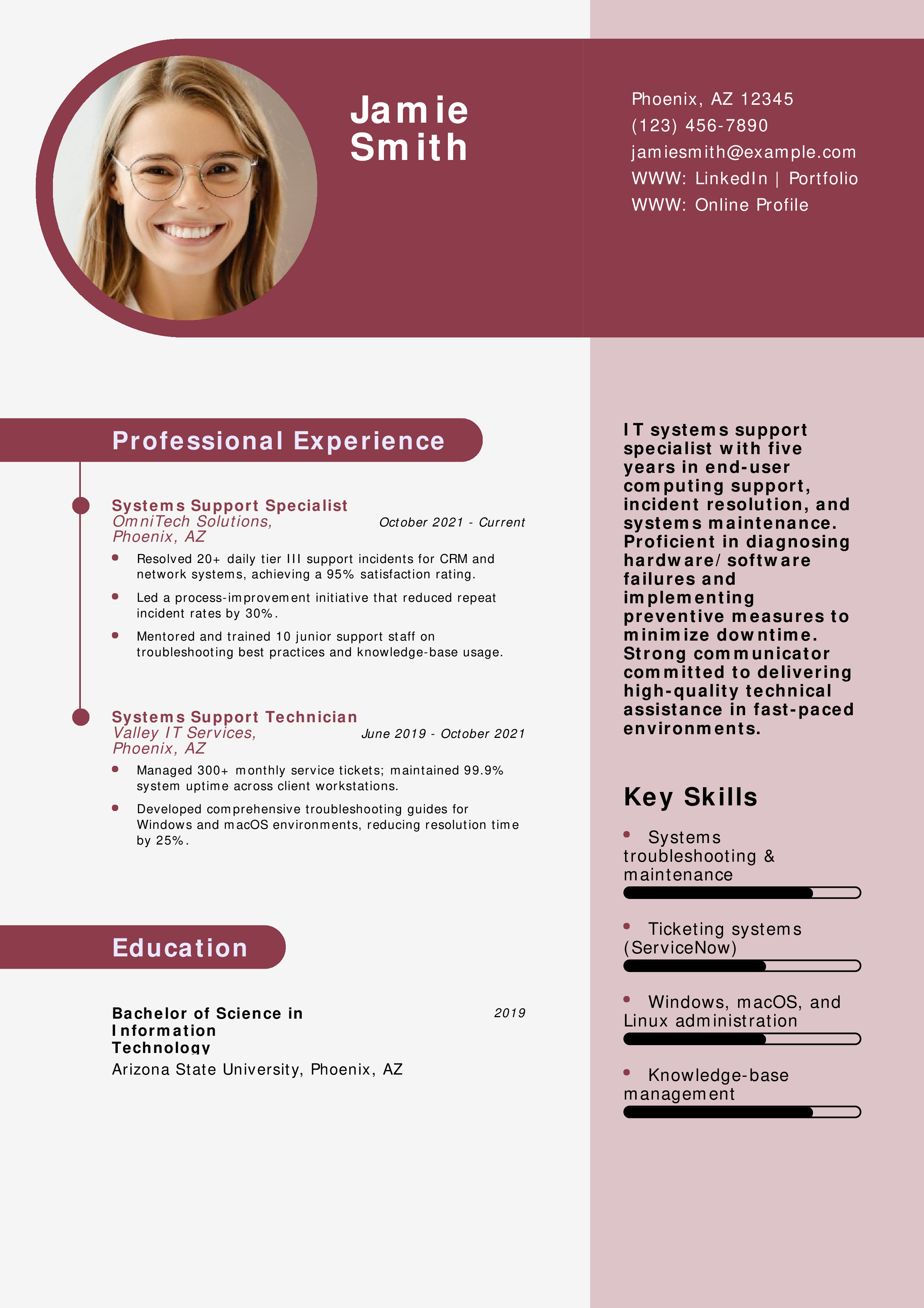
Why This Resume Is a Great Example:
Jamie’s resume highlights cross-platform systems expertise and process improvements quantified by satisfaction metrics and repeat-incident reduction.
Key Tip
Showcase quantitative support outcomes and mentorship roles to demonstrate leadership and technical depth. For tips on showcasing technical skills, see Resume Skills.
IT Infrastructure Engineer Resume
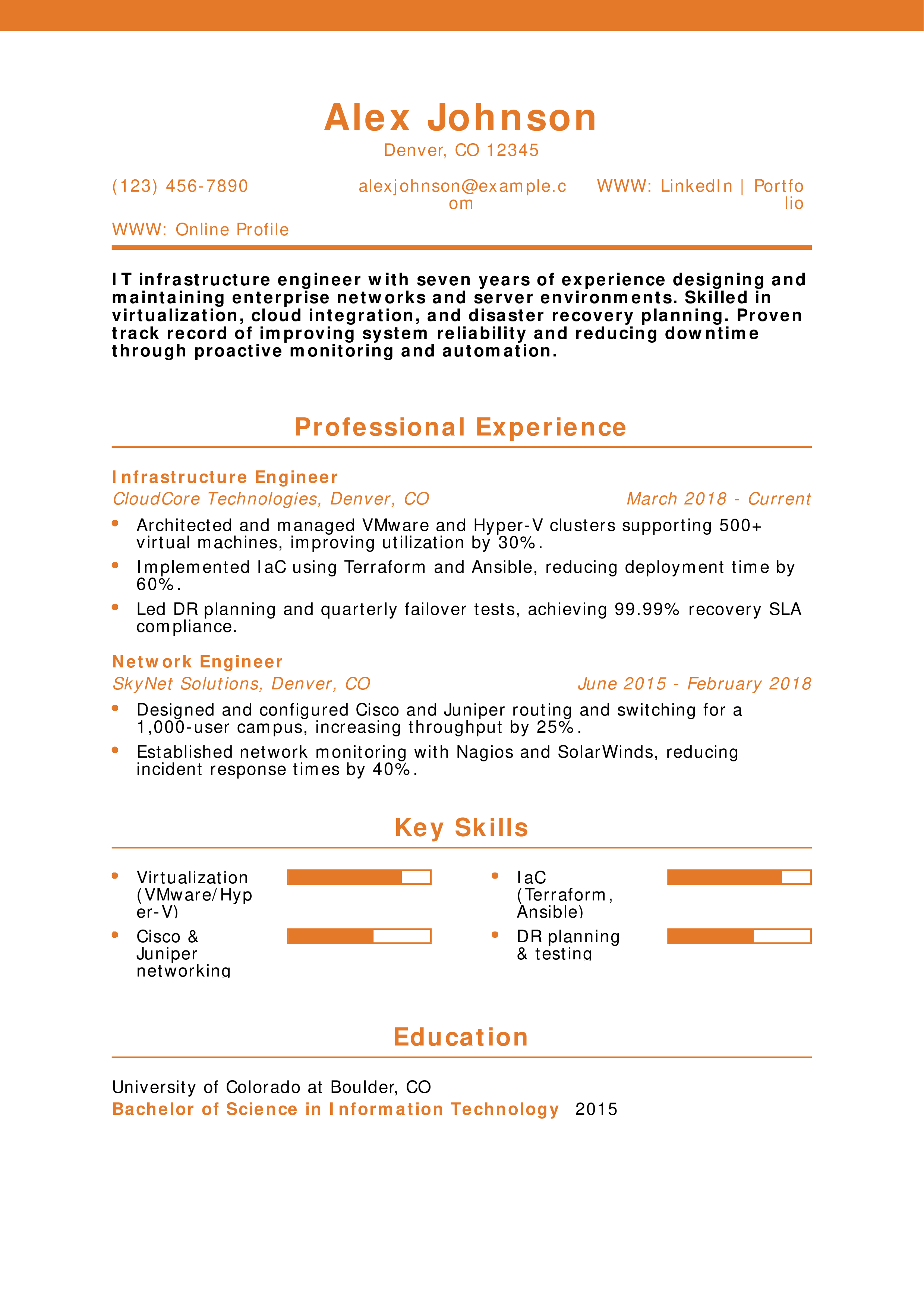
Why This Resume Is a Great Example:
Alex’s resume demonstrates deep infrastructure expertise, highlighting virtualization, automation, and DR successes.
Key Tip
Focus on automation and reliability metrics to showcase your impact. For network design best practices, see Technical Skills for a Resume.
IT Infrastructure Engineer Resume
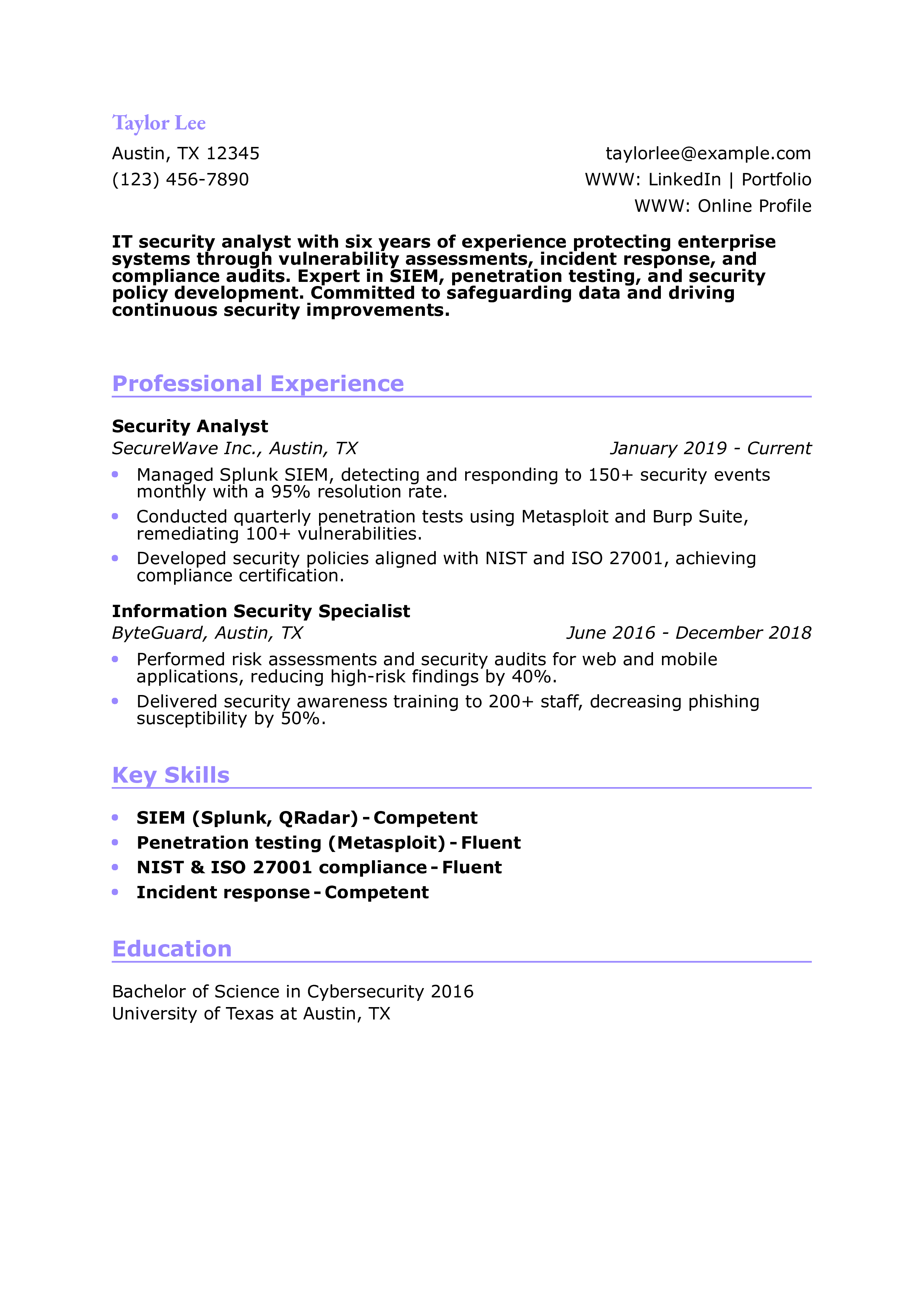
Why This Resume Is a Great Example:
Taylor’s quantifiable security improvements and compliance achievements show strong analytical and governance skills.
Key Tip
Emphasize your vulnerability management and compliance successes. For guidance on certifications, see How to List Certifications on a Resume.
IT Consultant Resume
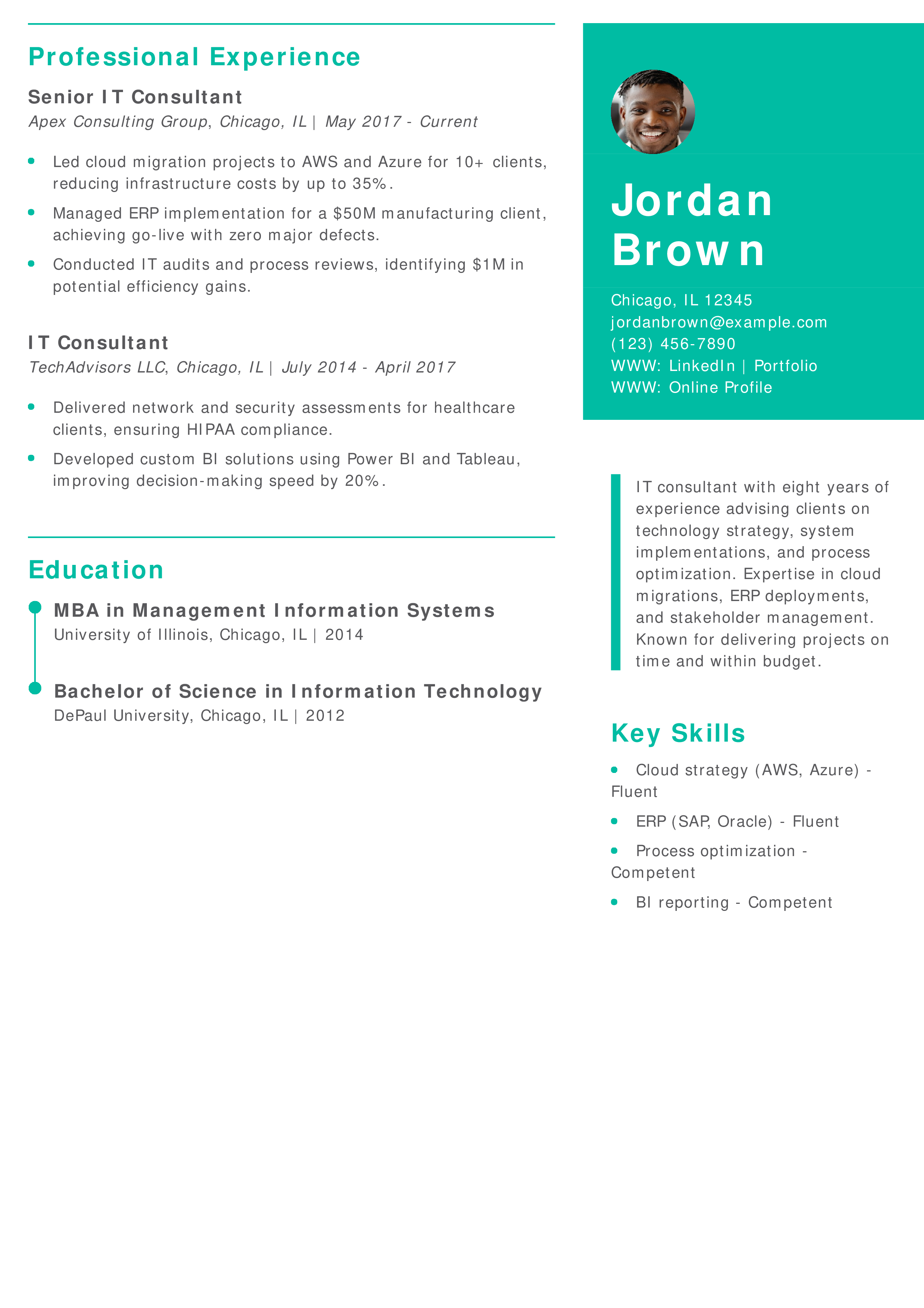
Why This Resume Is a Great Example:
Jordan’s consulting resume highlights strategic impact through cost savings and compliance achievements.
Key Tip
Showcase client outcomes and process improvements. For objective examples, see Resume Objective Examples.
IT Programmer Resume
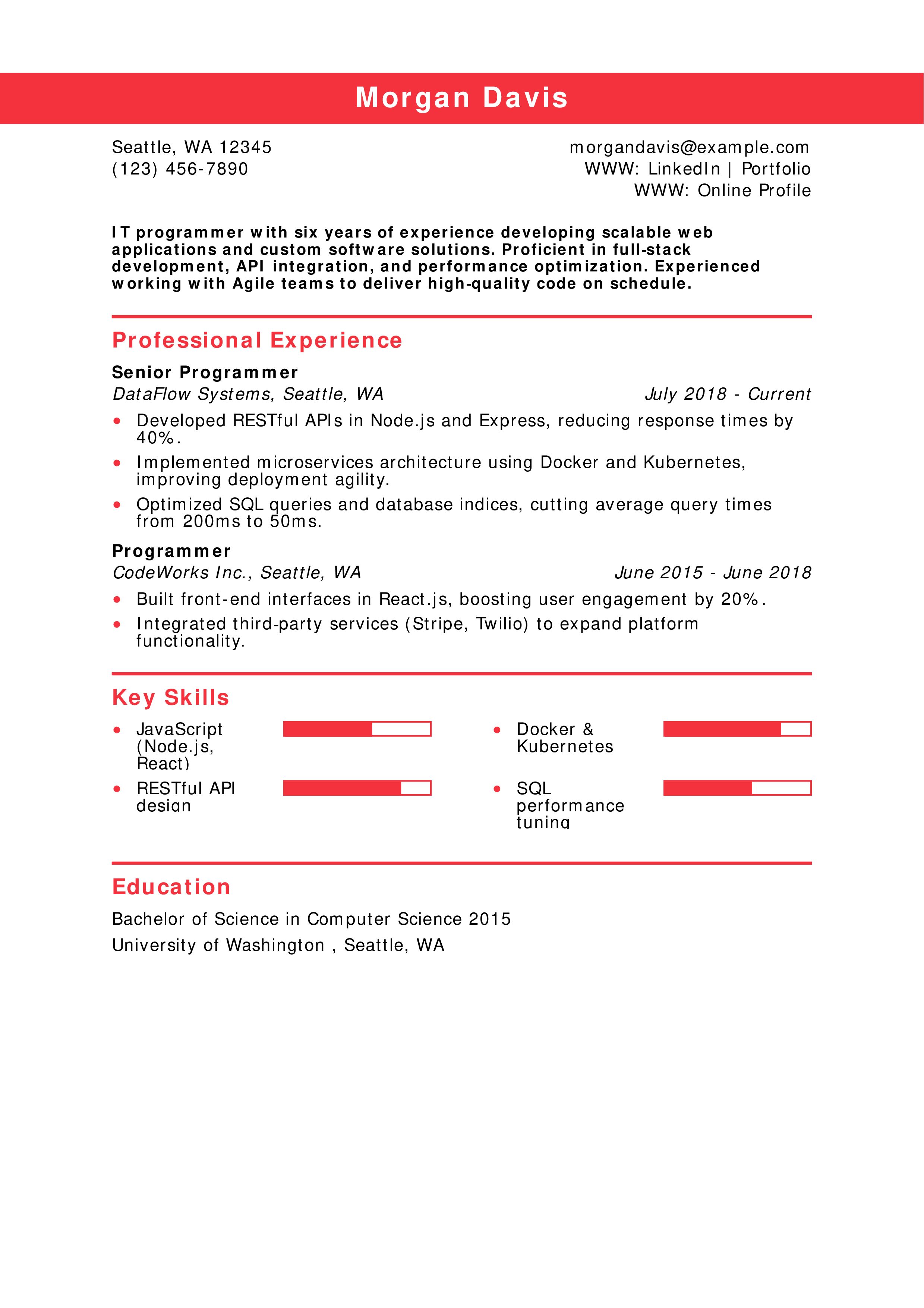
Why This Resume Is a Great Example:
Morgan’s resume clearly demonstrates full‑stack proficiency, performance gains, and modern DevOps practices.
Key Tip
Highlight both front‑ and back‑end successes to show full‑stack capability. For coding best practices, see Technical Skills for a Resume.
IT Developer Resume
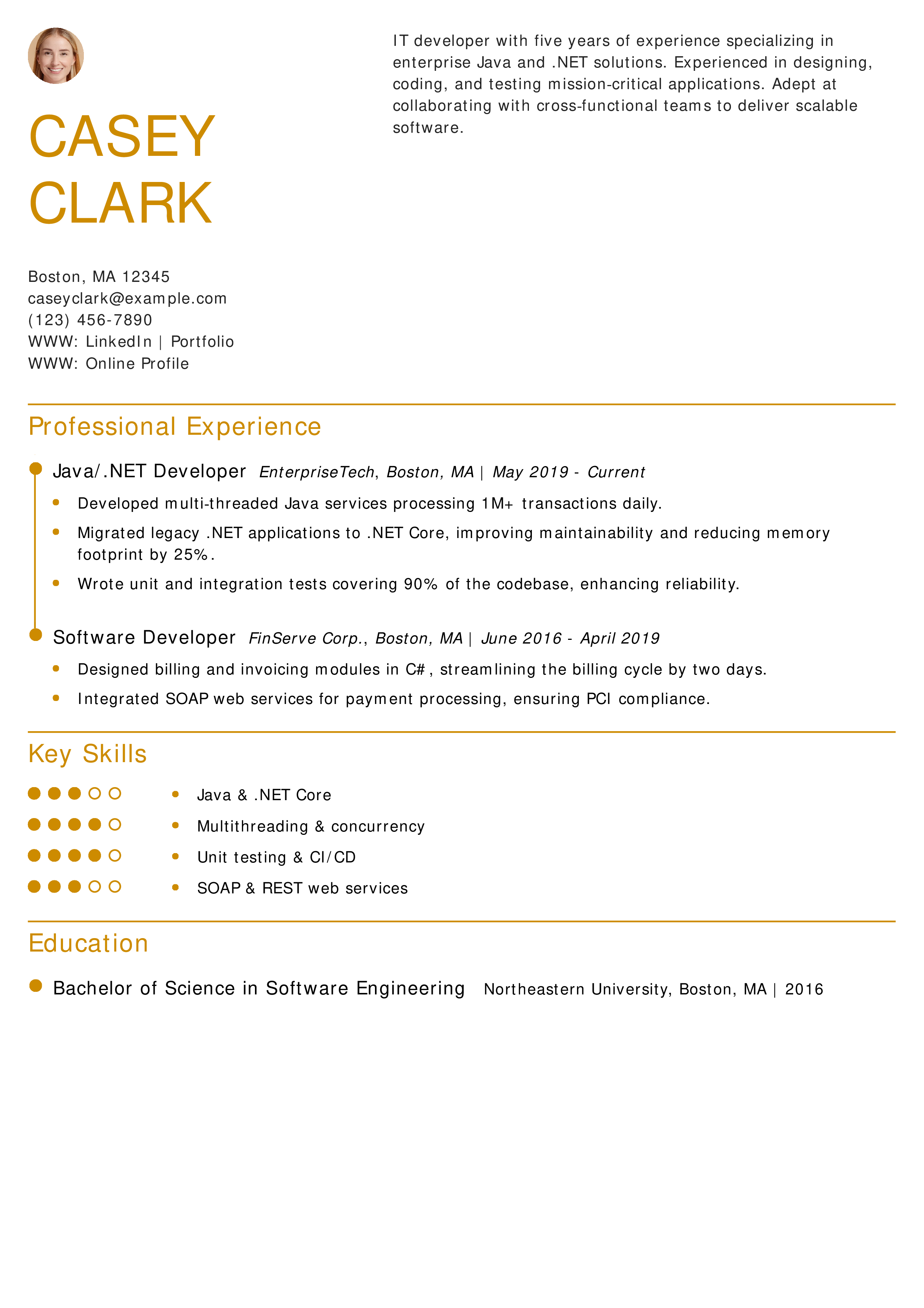
Why This Resume Is a Great Example:
Casey’s combination of legacy modernization and rigorous testing illustrates strong developer best practices.
Key Tip
Emphasize code quality and modernization efforts to show forward‑thinking development. For resume formatting guidance, see Best Resume Formats.
IT Engineer Resume
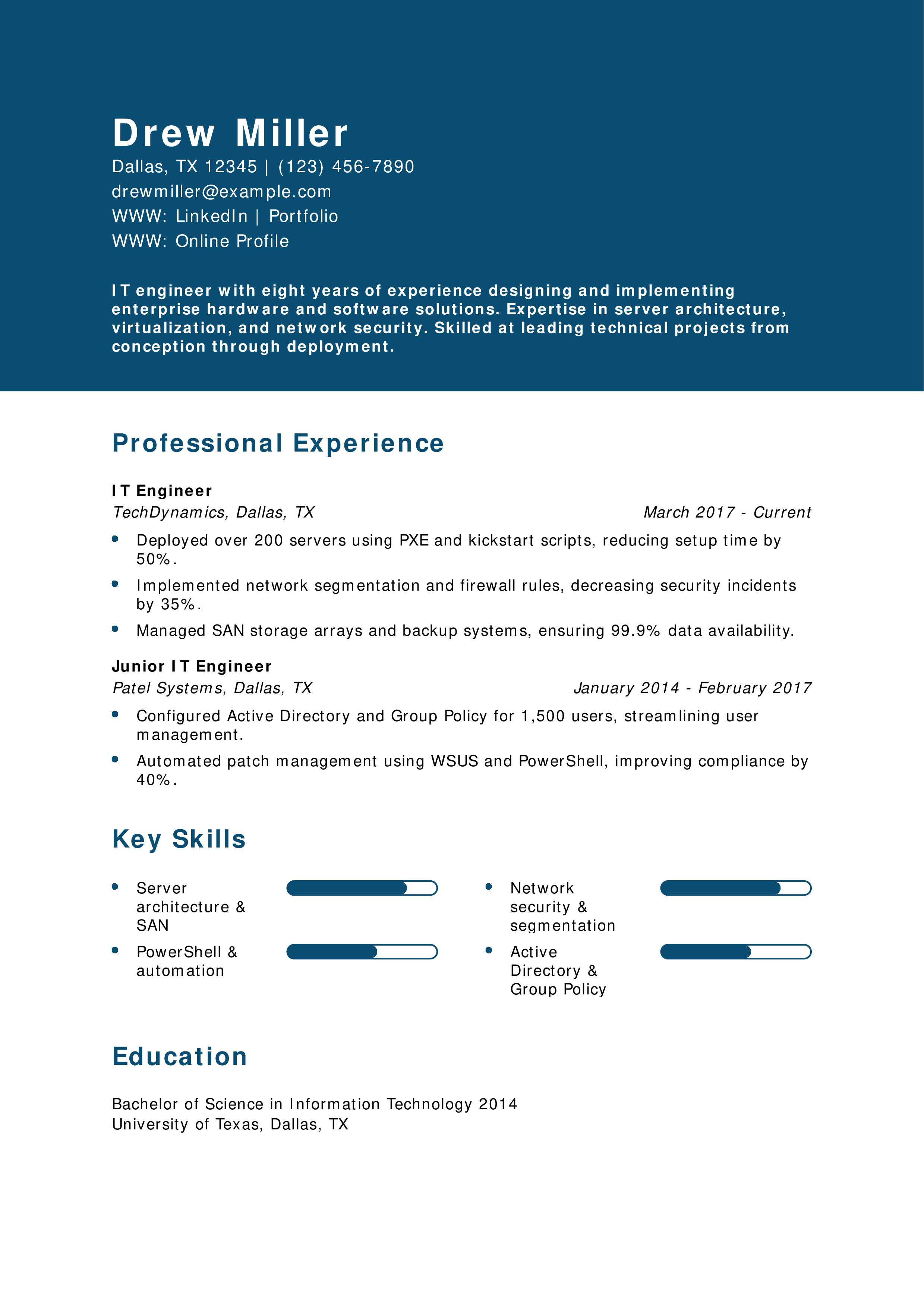
Why This Resume Is a Great Example:
Drew’s resume emphasizes automation, security improvements, and large‑scale deployments to demonstrate robust IT engineering skills.
Key Tip
Showcase automation and security metrics to highlight the impact of engineering. For certification best practices, see How to List Certifications on a Resume.
IT Network Administrator Resume
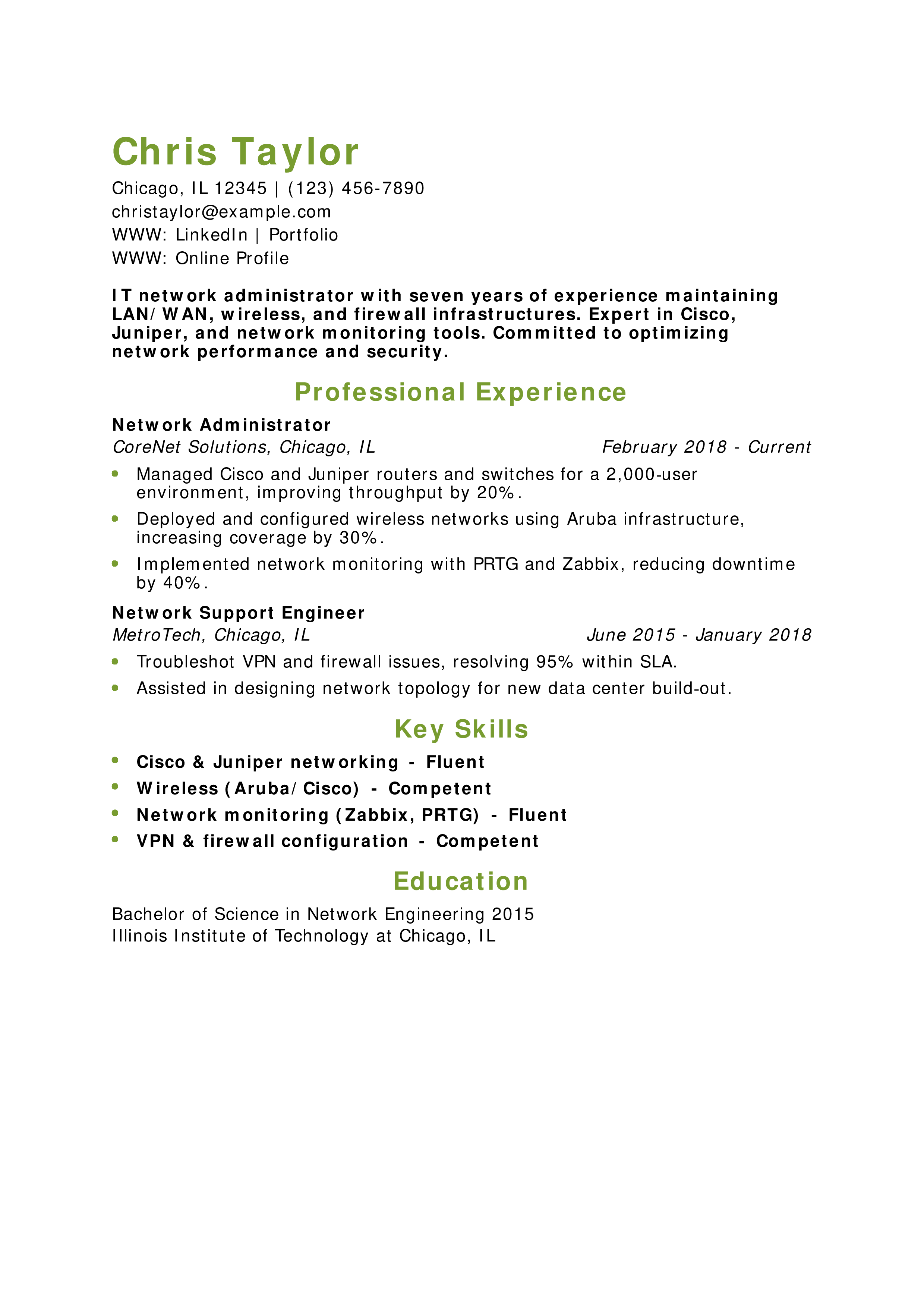
Why This Resume Is a Great Example:
Chris’s accomplishments in throughput gains and monitoring adoption underscore his network optimization capabilities.
Key Tip
Highlight metrics around uptime and performance. For network design resources, see Resume Skills.
IT Infrastructure Architect Resume
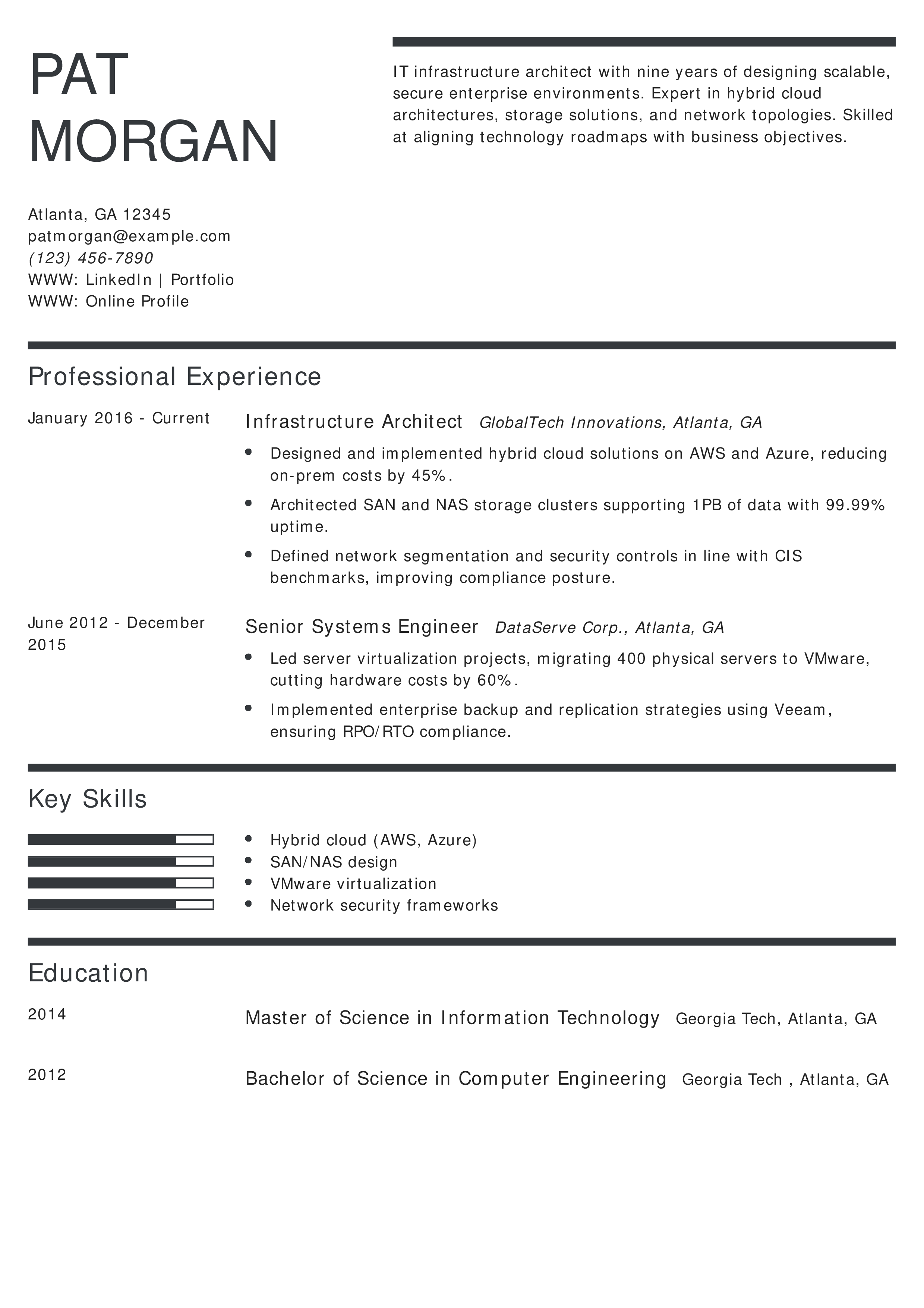
Why This Resume Is a Great Example:
Pat’s resume highlights high-level architecture work with clear cost savings and compliance improvements.
Key Tip
Demonstrate how your architecture decisions align with business goals. For cloud strategy insights, see CV vs. Resume.
IT DevOps Engineer Resume
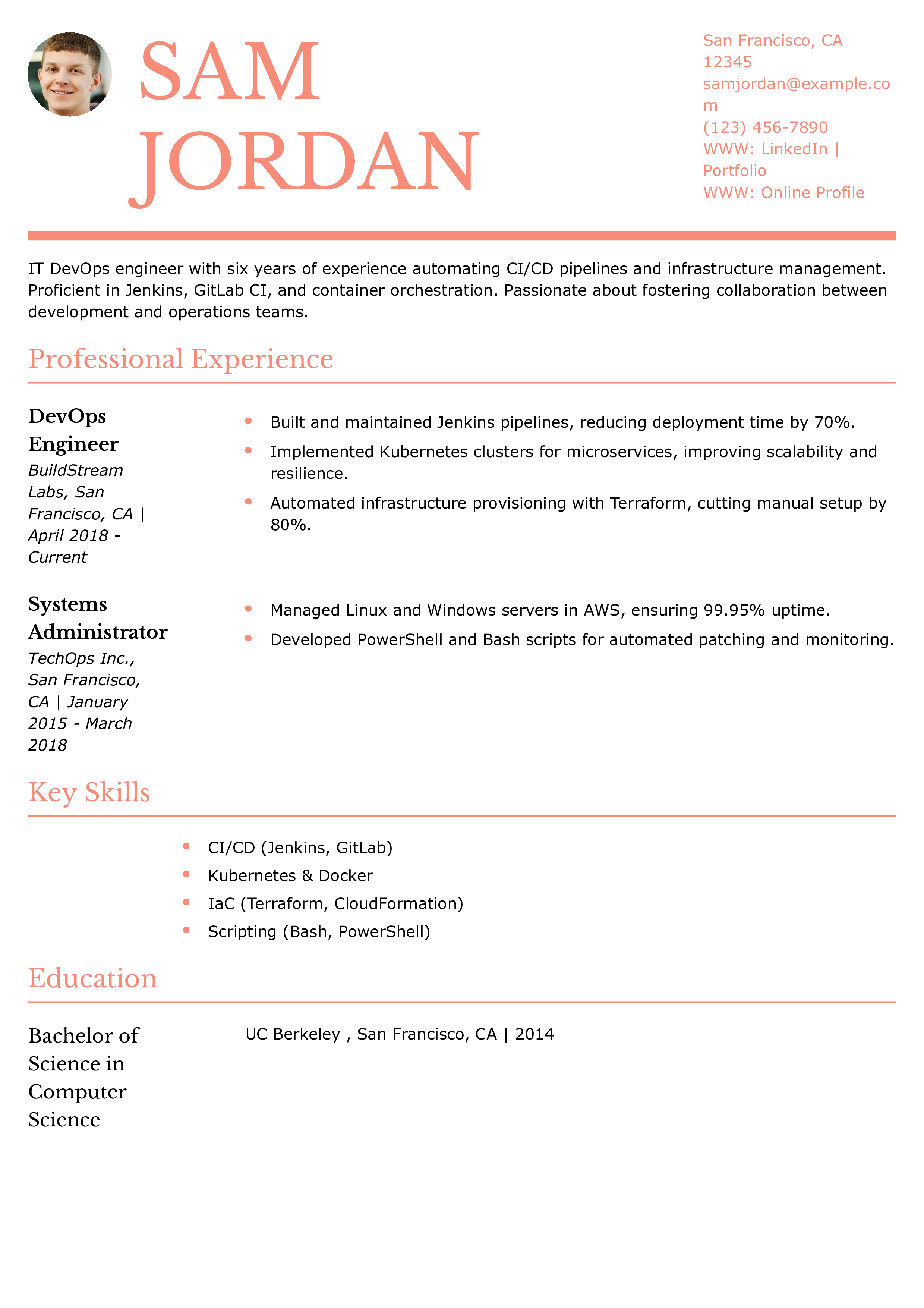
Why This Resume Is a Great Example:
Sam’s resume demonstrates strong automation impact, quantifying deployment speed improvements and reliability metrics.
Key Tip
Highlight deployment metrics and tooling proficiency. For DevOps best practices, see Resume Skills.
IT Specialist Resume
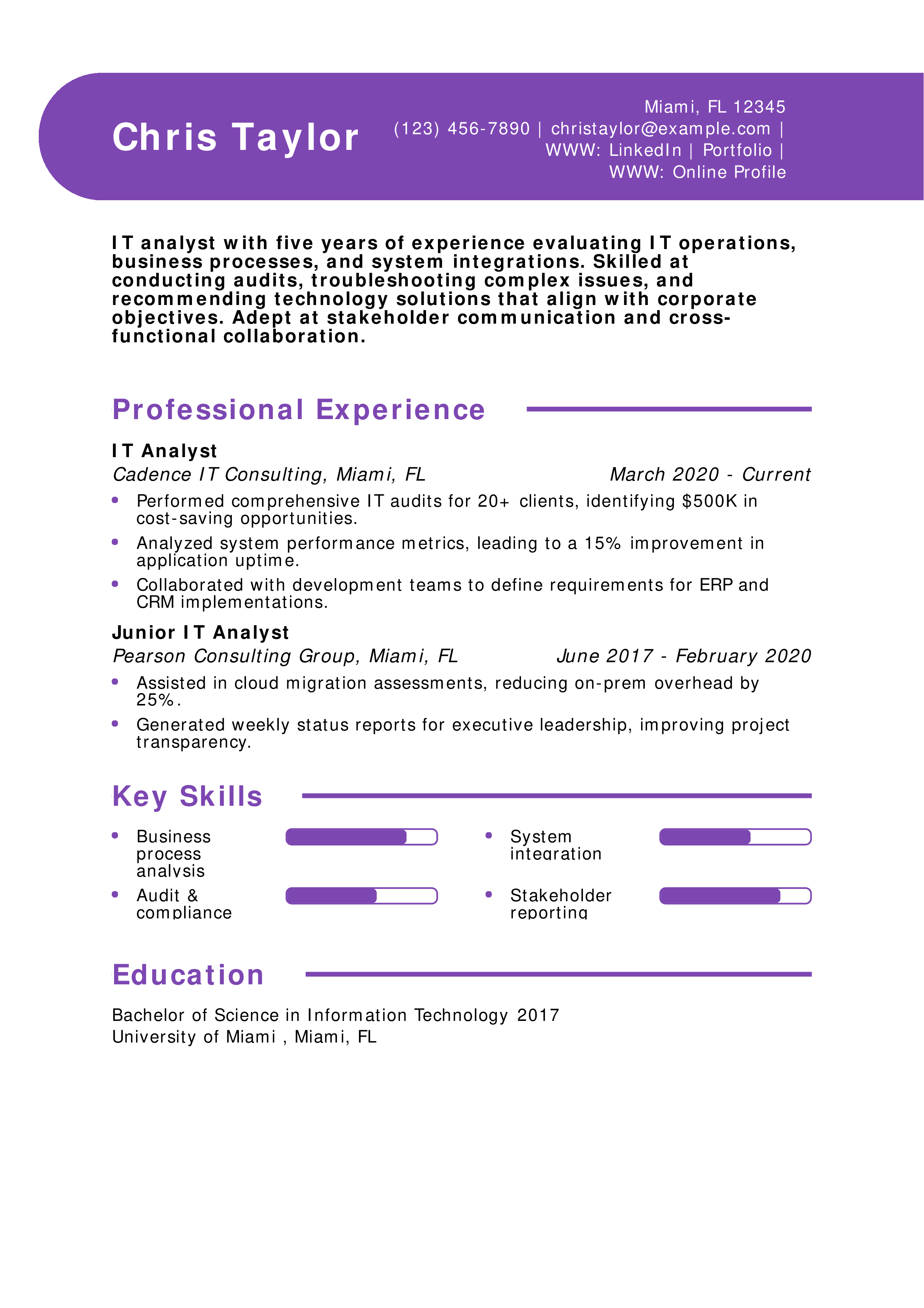
Why This Resume Is a Great Example:
Chris’s resume emphasizes business impact through cost savings and system uptime improvements, showcasing analytical and communication strengths.
Key Tip
Tie your analysis to measurable business outcomes and clear reporting. For insights on quantifying results, see What to Put on a Resume.
IT Infrastructure Manager Resume
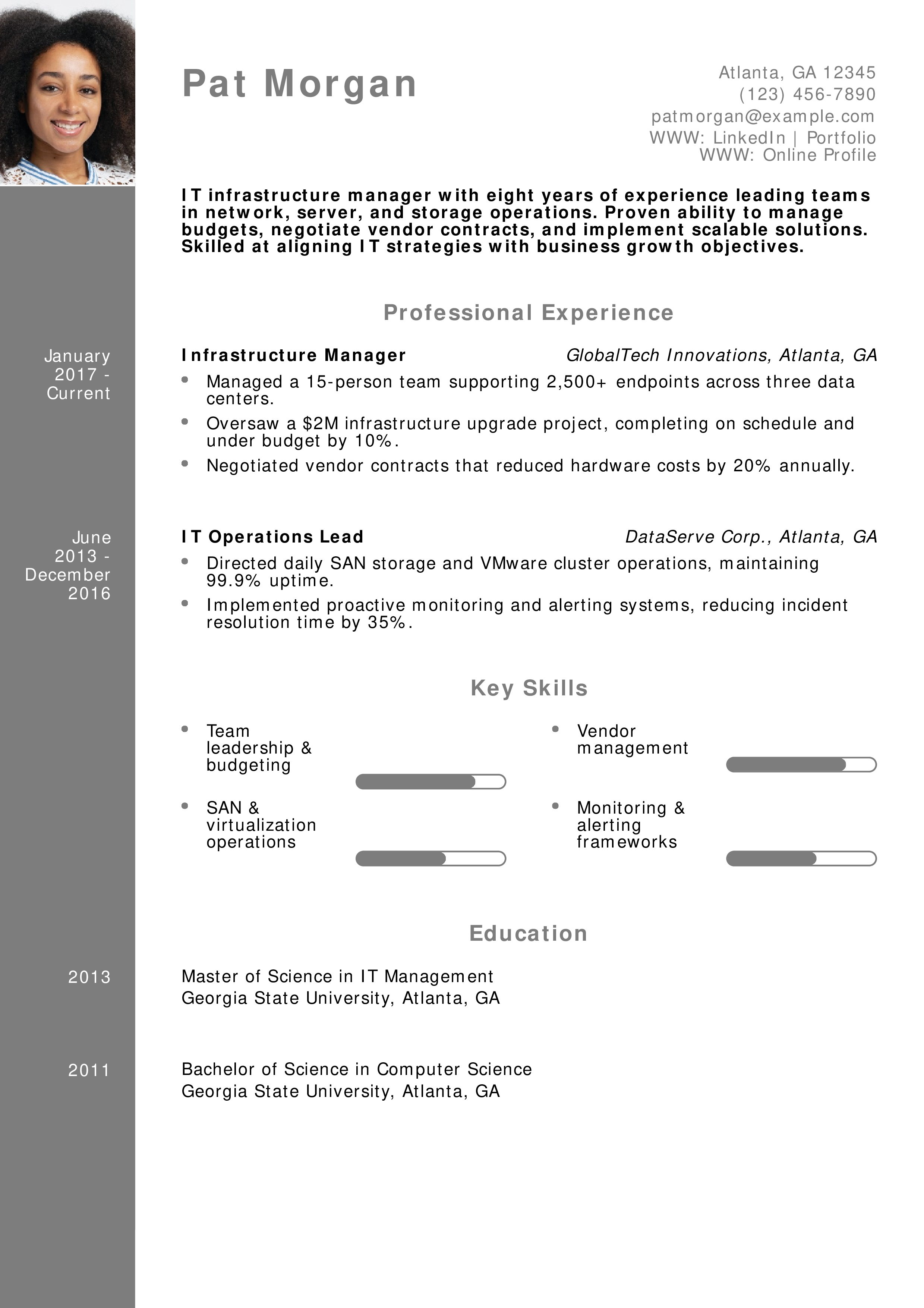
Why This Resume Is a Great Example:
Pat’s leadership in cost control, team management, and proactive operations highlights strong managerial expertise.
Key Tip
Showcase budget and vendor negotiation achievements to underscore management skills. For guidance on resume length, see Should a Resume Be One Page?
IT Infrastructure Specialist Resume
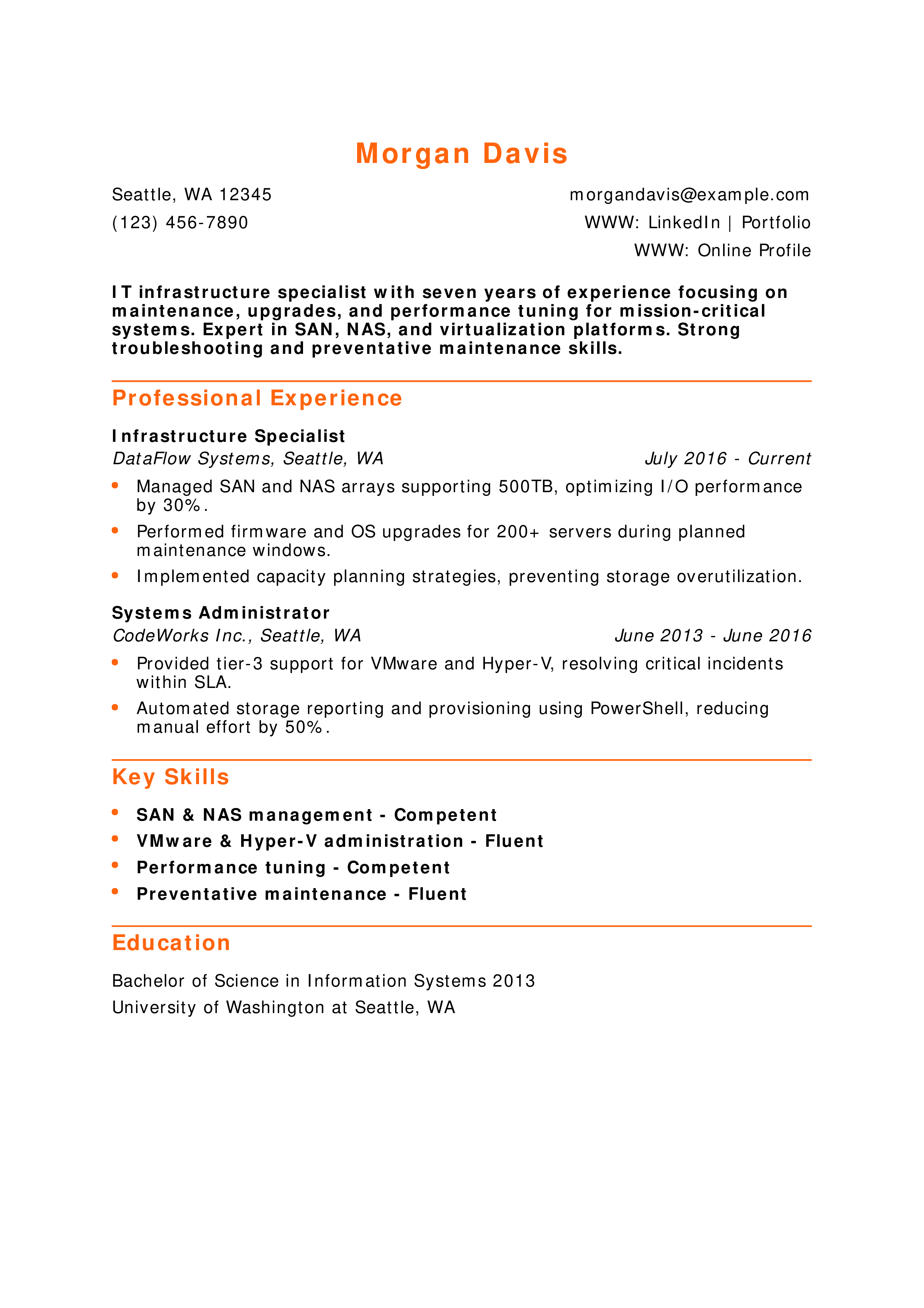
Why This Resume Is a Great Example:
Morgan’s resume highlights storage performance optimization and automation, showcasing core infrastructure skills.
Key Tip
Detail performance metrics and automation efforts to demonstrate technical impact. For storage best practices, see Resume Outline Examples.
IT Programmer Analyst Resume
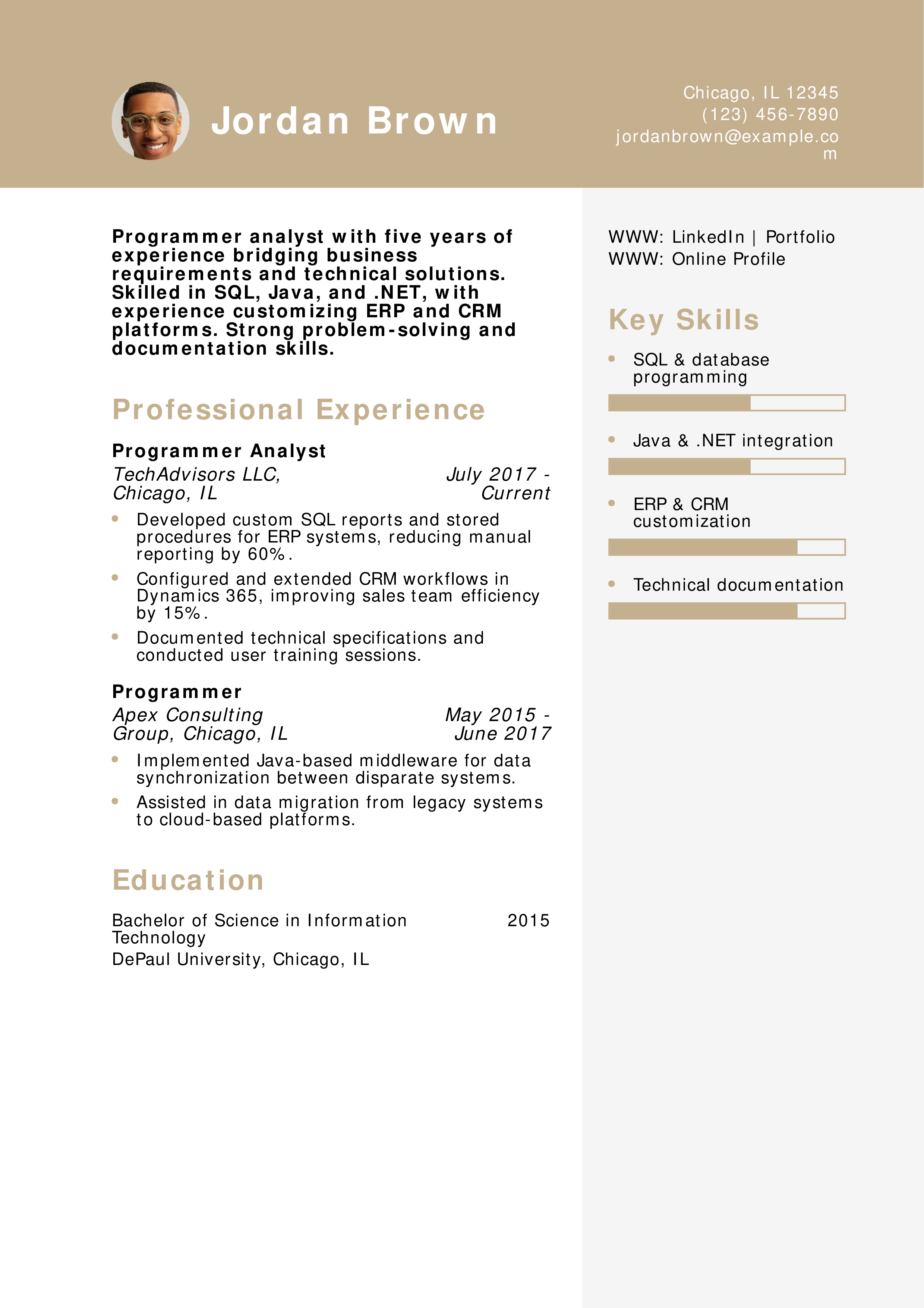
Why This Resume Is a Great Example:
Jordan’s resume demonstrates the combination of programming and analysis to deliver business value through automation and integration.
Key Tip
Highlight your ability to translate business needs into technical solutions. For insights on listing skills, see Resume Skills.
IT Business Analyst Resume
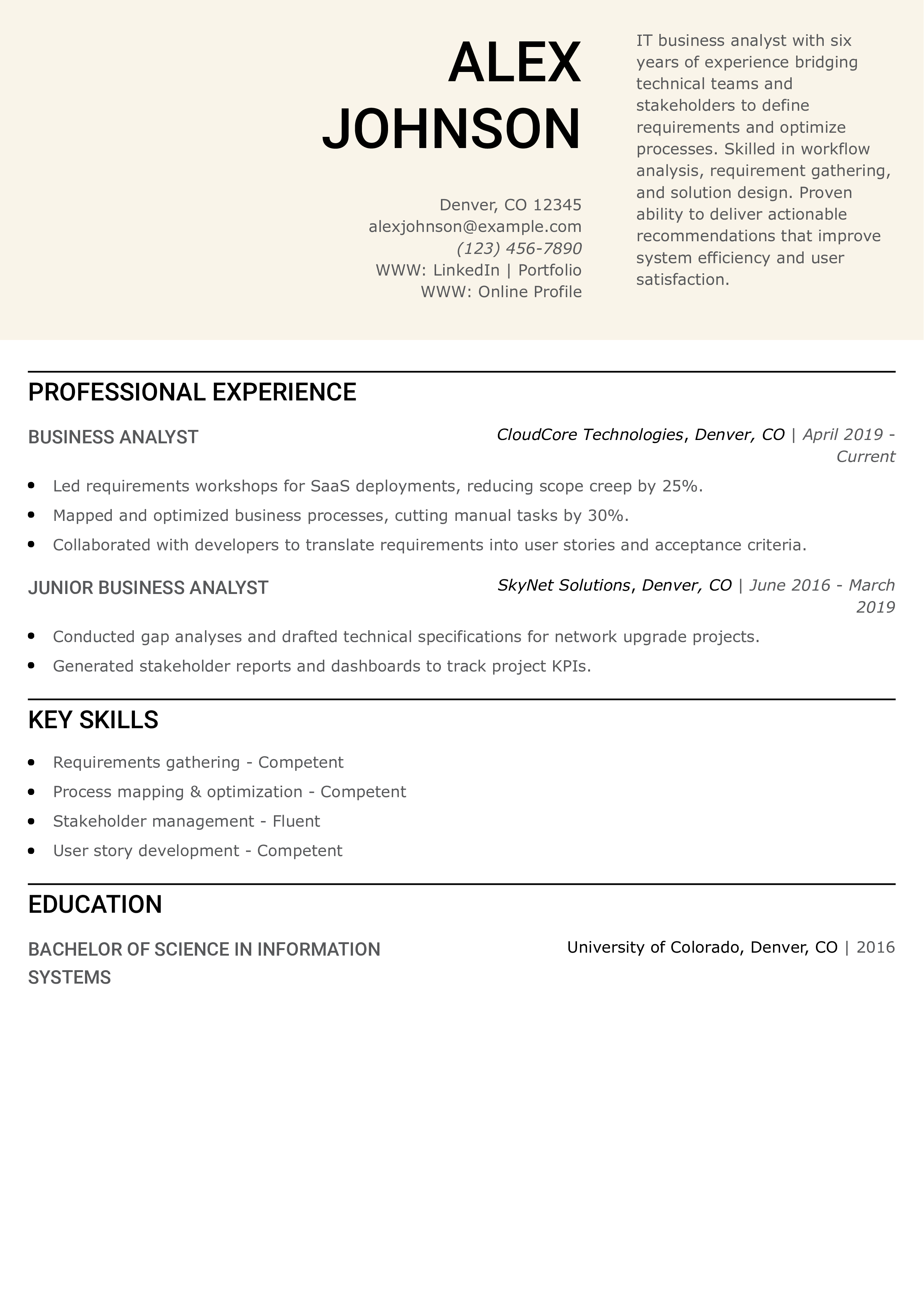
Why This Resume Is a Great Example:
Alex’s resume demonstrates his ability to streamline processes and deliver clear requirements, directly contributing to deployment success.
Key Tip
Highlight your impact on process improvements and stakeholder alignment. For resume summary guidance, see Resume Summary Examples.
IT Desktop Support Resume
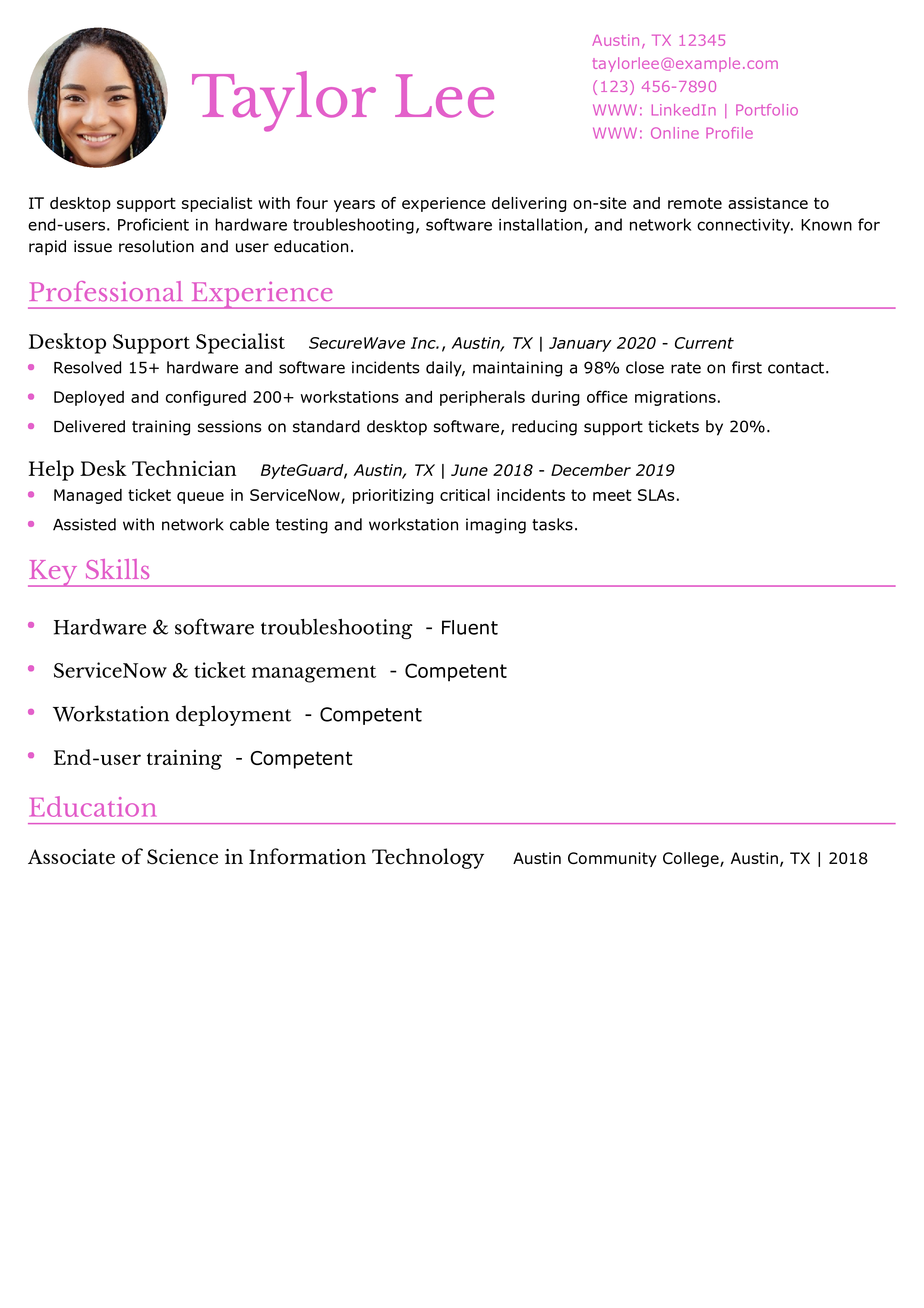
Why This Resume Is a Great Example:
Taylor’s first-contact resolution metrics and deployment experience demonstrate strong desktop support capabilities.
Key Tip
To showcase your support effectiveness, emphasize resolution rates and user training initiatives. For help desk best practices, see How to Make a Resume.
IT Trainer Resume
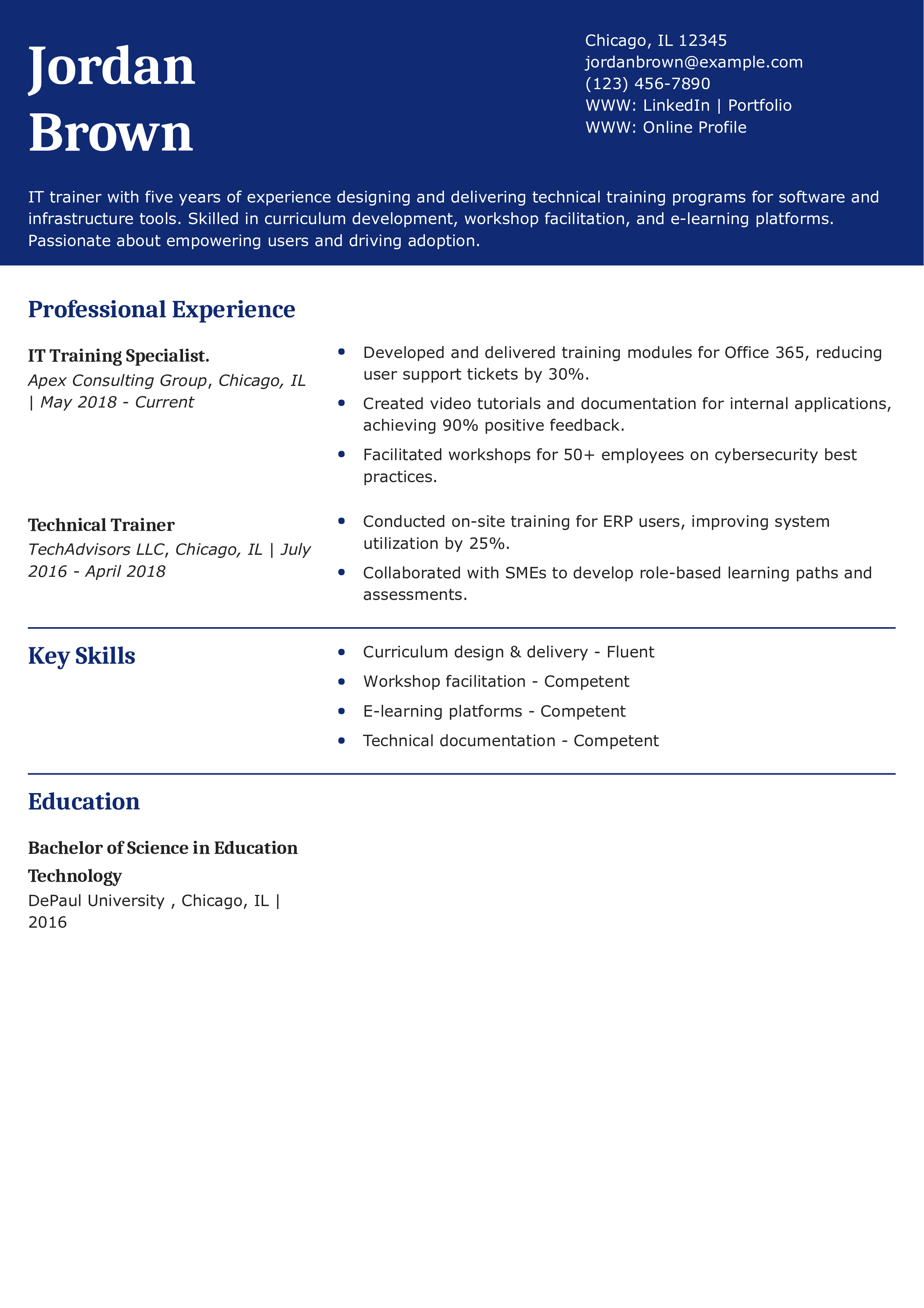
Why This Resume Is a Great Example:
Jordan’s resume highlights measurable training outcomes and high user engagement, demonstrating effective instructional design.
Key Tip
Showcase training metrics and content development skills to illustrate instructional impact. For volunteer section inspiration, see How to Put Volunteer Work on a Resume.
IT Project Manager Resume
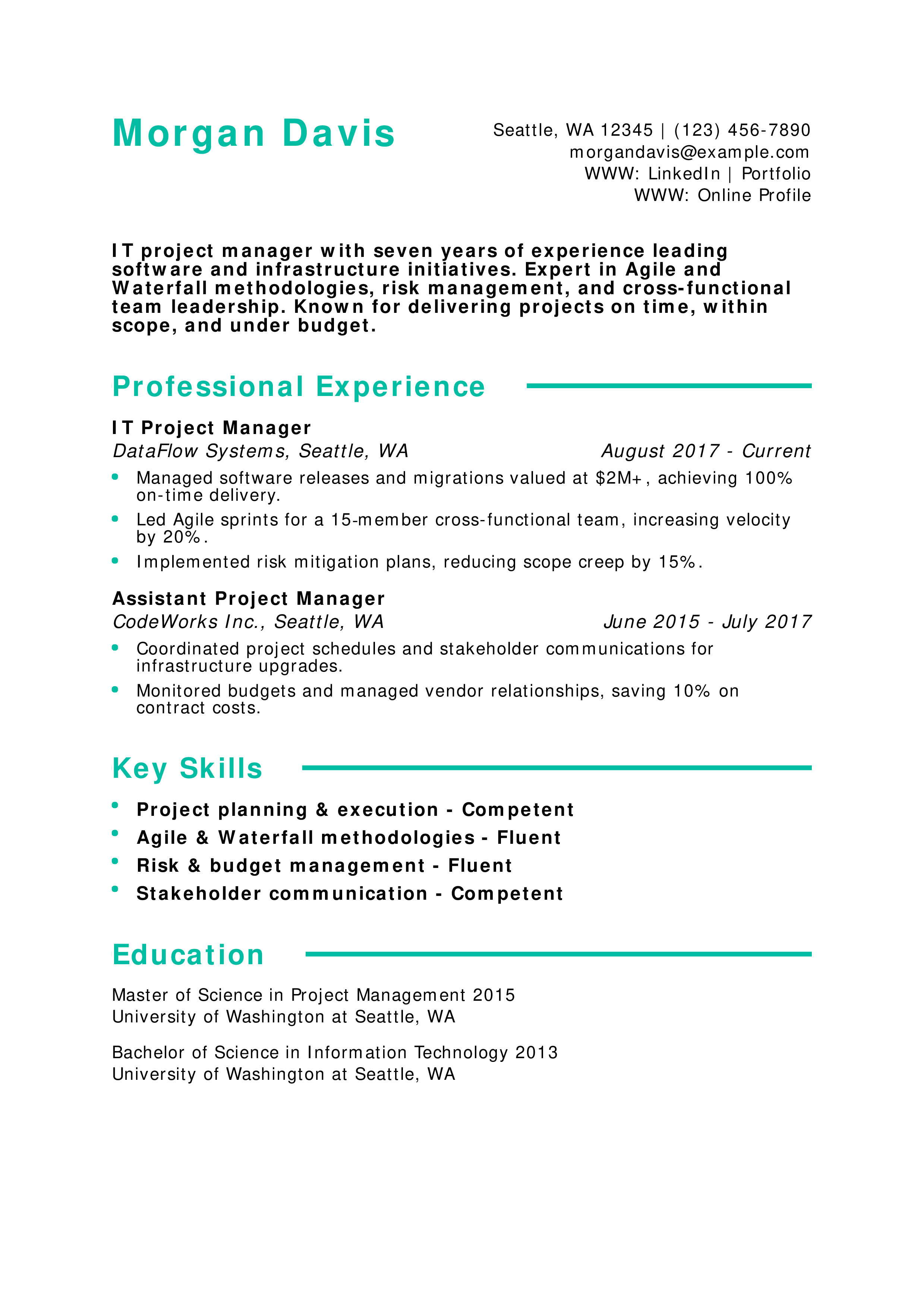
Why This Resume Is a Great Example:
Morgan’s project delivery metrics and Agile leadership showcase her ability to drive complex initiatives.
Key Tip
Highlight delivery metrics and methodology expertise to emphasize your project management impact. For resume interests ideas, see the Resume Interests Section.
Our templates are crafted by professional resume writers to make creating your resume quick, easy, and effective.
- Professional resume template downloads
- Customized cover letter generation
- AI resume writing support
- Career-building resources and advice
Information Technology Text-Only Resume Templates and Examples
How To Write an Information Technology Resume
1. Craft an outstanding profile with a summary of your information technology (IT) qualifications
It’s important to make a positive first impression on the hiring manager, so ensure that you have an eye-catching professional summary at the top of your resume. Your professional profile should highlight your title, years of experience, and key specializations in the opening sentence. This is perhaps the most important section to align with your target job posting. Show hiring managers that you’re qualified for the position as quickly as possible. Below, you’ll find some examples of IT professional profiles:
Senior-Level Profile Example
Profile
A senior cybersecurity specialist with 11 years of experience developing complex infrastructures and technical solutions for industry and government clients. A proven track record of conducting comprehensive vulnerability assessments and educating internal users on threat prevention procedures.
Entry-Level Profile Example
Profile
A passionate user experience (UX) designer with three years of professional experience specializing in developing accessible technologies to promote empathy and understanding. Adept at collaborating with diverse teams to incorporate different viewpoints and ensure technological solutions meet the needs of all users.
2. Showcase your information technology (IT) experience
As you build your professional experience section, incorporate hard numbers and metrics to bolster your achievements. It is important to provide the hiring manager with the necessary information and context to facilitate a more thorough understanding of your professional background. Also, balance your content to ensure that your bullet points are accessible to non-technical readers but still engaging for technical hiring managers. Below, you’ll find some examples to guide you as you craft your professional experience section:
Senior-Level Professional Experience Example
Professional Experience
Cyber Security Specialist, Delta Communication Technologies, San Diego, CA
July 2017 – present
- Deliver cybersecurity consulting services to industry and government clients valued at $5 million to $10 million, monitor networks for security breaches, and identify opportunities to enhance data security protocols and threat prevention
- Conduct penetration testing to locate vulnerabilities in the system and strengthen security before vulnerabilities can be exploited
- Coordinate with senior leadership with management to develop training materials and procedures for cybersecurity
Entry-Level Professional Experience Example
Professional Experience
UX Designer, Black Cat Apps, San Francisco, CA
November 2021 – present
- Oversaw UX design for the development of three mobile apps with over 10 million downloads to date, resulting in coverage of applications from Mashable and Techcrunch
- Collaborate with designers, developers, research managers, and producers to develop creative solutions accessible to users with diverse needs
- Conduct front-end programming using HTML 5, CSS, and JavaScript to develop and build web-based prototypes
3. Outline your education and information technology (IT)-related certifications
In addition to your education, acquiring additional technical certifications can strengthen your application as you pursue IT jobs. Analyzing a wide range of job postings will help you determine what industry certifications to obtain. Another important factor to consider is understanding what area of tech space you’re passionate about. For instance, if you’re interested in a career as a cybersecurity professional, pursue a CSSLP or CISM certification. Obtaining relevant certifications will also show organizations that you’re committed to continuing your education, which will reflect positively on who you are as a candidate.
Certifications
Template
- [Certification Name], [Awarding Organization], [Completion Year]
Example
- CIW Web Development Professional, 2018
- Certified Software Development Professional, IEEE, 2017
Education
Template
- [Degree Name]
- [School Name], [City, State Abbreviation] [Dates Enrolled]
Example
- Bachelor of Science (B.S.) Information Technology
- Temple University, Philadelphia, PA September 2012 – June 2016
4. Include a list of your skills and proficiencies related to information technology (IT)
Most employers use applicant tracking systems (ATS) to identify candidates who meet the position’s requirements. These resumes are passed on to the hiring manager, so the more keywords you include, the more likely you’ll be invited for an interview. As you begin searching for new opportunities, carefully analyze each job posting to ensure your resume matches the needs of the organization you’re applying to. Below are key terms and skills that you may encounter during the job search:
| Key Skills and Proficiencies | |
|---|---|
| Agile methodology | Amazon Web Services (AWS) |
| Cisco | Cloud technology |
| Computer science | Cybersecurity |
| End-user training | Hardware deployment |
| IT | Linux |
| Mac OS | Microsoft OS |
| Network administration | Network configuration |
| Root cause analysis | Software development lifecycle (SDLC) |
| System implementation | System migration |
| Technical project management | Technical support |
| User interface (UI) design | Vendor management |
| VMware | VPN |
How To Pick the Best Information Technology Resume Template
As an IT professional, select a template that is straightforward and easy to read. If your template has bulky graphics or distracting colors, you risk drawing the hiring manager’s eye away from your accomplishments. When in doubt, choose a well-structured template that keeps the reader’s focus on why you’re qualified for the position rather than focusing only on visual appeal.
Frequently Asked Questions: Information Technology Resume Examples and Advice
What is the best way to highlight my experience in my Information Technology CV?-
The best way to highlight your experience in your Information Technology CV is by emphasizing specific achievements in each role. Use bullet points to make your experience scannable and focus on results-driven accomplishments, such as improving processes or saving costs. Include quantifiable data like percentage increases or revenue growth to reinforce the impact of your work.
What are common action verbs for information technology resumes?-
Using action verbs is a great way to infuse your bullet points with a dynamic element. Be strategic when selecting verbs, as it's important to prioritize active language when describing your professional experience. Provide a mix of verbs, as repetition can cause your bullet points to appear stale and monotonous. Below, you'll find a comprehensive list of action verbs to help you during the resume-building process for your IT resume:
| Action Verbs | |
|---|---|
| Analyzed | Built |
| Conducted | Coordinated |
| Created | Debugged |
| Designed | Developed |
| Diagnosed | Enhanced |
| Executed | Identified |
| Implemented | Improved |
| Integrated | Led |
| Managed | Performed |
| Supported | Troubleshot |
How do you align your resume with a job description?-
The Bureau of Labor Statistics predicts that careers in computer and IT occupations will grow by 15% from 2021 to 2031, which equates to over 682,800 new jobs. Although the technology space continues to grow, you’ll still need to align your resume with the job description to generate interviews during your search.
As you build your resume, it’s important to evaluate how your experience and technical knowledge match the organization’s needs. If you’re pursuing a career in software development, for example, you’d likely demonstrate your experience in Scrum, Agile, and Waterfall methodologies. You can showcase your knowledge of multifactor authentication and penetration testing if the company seeks a cybersecurity expert to help it enhance security systems. By customizing your resume for individual job applications, you’ll greatly increase your chances of landing the interview.
What is the best information technology resume format?-
Many IT professionals make the mistake of using a functional resume format instead of a reverse chronological approach. Although technical skills are undoubtedly important and should be featured heavily in your document, also provide hiring managers with specific examples of you applying your technological skills in a business environment. With a reverse chronological approach, you’ll ensure your most recent and relevant achievements are highlighted closer to the top of your document.
How many pages should my information technology resume be?-
Generally, an information technology resume should be one page for candidates with fewer than 10 years of experience. A two-page resume is acceptable if you’re a seasoned professional with extensive accomplishments—but only if it provides meaningful details that strengthen your application. Tailor your content to the job, focusing on your most relevant qualifications.
Work history should typically cover the last 10 to 15 years. Older positions can be excluded or briefly summarized unless they’re highly relevant. A concise, focused resume demonstrates your ability to prioritize and communicate effectively.
Craft your perfect resume in minutes
Get 2x more interviews with Resume Builder. Access Pro Plan features for a limited time!

Although not every organization will require a cover letter, it’s beneficial to have one prepared for those that do. This also provides a unique opportunity to show prospective employers how your core values and technical acumen align with the company’s work culture and organizational needs. In the middle paragraph, mention something specific about the company you’re applying to. This will show hiring managers you’ve researched beforehand and are genuinely interested in the position. For more insights, view our information technology (IT) cover letter guide.




